PERRY, EDGAR (1839-1864). Lieutenant colonel, 139th New York Infantry, Company F. Perry, a native of New Hurley, New York, and a bookkeeper by trade, had two grandfathers who served in the Revolutionary War. He enlisted as a captain at Brooklyn on September 6, 1862, was commissioned into the 139th New York three days later, and was promoted to lieutenant colonel on August 14, 1863. During his service, the 139th was engaged in the following Virginia battles: Williamsburg; Bottoms Bridge, Charles City Court House, Swift Creek, Petersburg, Drewry’s Bluff, and his final battle, Cold Harbor. Perry commanded the 139th at Cold Harbor, which began May 31, 1864, and was killed in action by a sharpshooter on June 2.
Civil War Bio Search

Perry’s death was cited on June 10, 1864, in the battle report of Brigadier General Gilman Marston, United States Army, who described conditions there as murderous, with 574 wounded, missing or dead, including 23 commissioned officers: “…Many brave officers of the line also perished in the vain attempt to drive the enemy from their strong position. When it was apparent that further effort would only result in useless slaughter, the men returned, a portion to the partial cover of the embankment from which the enemy had been driven, and the rest to the shelter of the wood through which they had advanced. At midnight the brigade was withdrawn to the open ground in rear of the wood through which the advance had been made in the morning with ranks terribly thinned, but with undiminished courage and faith in our ultimate success.”
As per his obituary in the Brooklyn Daily Eagle, Perry’s uncle was the late Colonel James H. Perry of the 48th Brooklyn who died at Fort Pulaski, Georgia. That obituary said of Edgar Perry, “A brave and promising young officer and patriot has fallen while fighting for his beloved country; and although in the prime of life, hope, and usefulness, he fell as a brave soldier delights to fall, if fall he must, with his face to the foe, in defense of a noble cause and of his native land.”
On July 15, 1864, Major General Benjamin F. Butler bestowed this honor, “Battery No. 2 is named Battery Perry, after Lieut[enant] Col[onel] Edgar Perry, One hundred and thirty-ninth New York Volunteers…” Section 167, lot 16796.

PERRY, JAMES H. (1843-1863). Private, 79th New York Infantry, Company K. Of Irish birth, Perry enlisted as a private at New York City on May 13, 1861, mustered into the 79th New York, known familiarly as the Highlanders, on May 28, and was discharged for disability by surgeon’s certificate) on August 8 of that year. Perry last lived in New York City. Section 85, lot 6142.

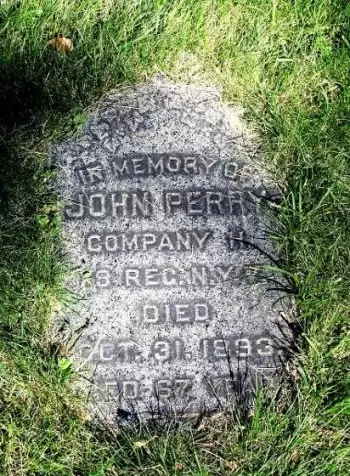
PERRY, JOHN (1826-1893). Private, 79th New York Infantry, Company H. Originally from Ireland, the 1860 census reports that Perry lived in New York City with his wife and infant daughter; he was employed as a driver and had a personal estate valued at $200. During the Civil War, he enlisted as a private at New York City on May 13, 1861, and mustered into the 79th New York, familiarly known as the Highlanders, on May 28. As per his muster roll, he was detailed to the Commissary Department in Post Lebanon, Kentucky, as a baker on April 14, 1863. Although listed as absent without leave as of June 17, 1863, his muster roll then notes that he was sick and in a New York City hospital; he was present on the muster roll as of October 1863. He mustered out with his company at New York City on May 31, 1864.
The 1870 New York City Directory lists Perry as a baker whose home address was at 318 East 31st Street. At the time of the 1880 census, he lived at 311 East 31st Street in Manhattan with his wife and four children, worked as a baker and reported that he suffered from rheumatism. According to the 1883 New York City Directory, he was still living at 311 East 31st Street and continued to work as a baker. In 1888, Perry’s application for an invalid pension was approved, certificate 621,791. The 1890 Veterans Schedule confirms his Civil War service.
His last residence was at 591 Second Avenue in Manhattan. He died from enteritis. As per his death certificate, Perry was married and worked as a baker. His obituary in the New York Herald states that comrades from the 79th New York were invited to attend his funeral. Shortly after his death in 1893, Frances Perry, who is interred with him, applied for and received a widow’s pension, certificate 393,500. Section 135, lot 27263, grave, 2312.
PERRY, WILLIAM FERRIS (1842-1920). Private, Louisiana Washington Artillery Battalion, Company C, Confederate States of America. Perry was born in New York City. As per his obituary in the Confederate Veteran, his family went to France when he was young and he was educated in Paris. After enlisting as a private at New Orleans, Louisiana, on May 26, 1861, Perry mustered into Company C of the Louisiana Washington Battalion, an artillery unit. The obituary states that he served under Generals Pierre G. T. Beauregard, James Longstreet, and Joseph E. Johnston during the Civil War. After his unit left its winter quarters in March of 1862, it camped on Terrill’s farm, near Orange Courthouse, where he met Virginia Terrell, the woman who would later become his wife. At that time, he and Virginia agreed that he would return to Terrill’s farm in the event that he was wounded. On December 13, 1862, Perry was severely wounded at the Battle of Fredericksburg, Virginia. Perry made his way back to Terrill’s farm where Dr. Terrill and his family nursed him back to health. Perry married Virginia in Orange, Virginia, in April of 1863.
After the War, Perry and Virginia returned to New York City, where he had been born. As per the 1910 census, he was a cashier in a grocery store, married, renting a house on 83rd Street in Manhattan and able to read and write. The 1920 census indicates that was a widower living at 133 West 83rd Street in Manhattan. His obituary concludes by noting, “Mr. Perry was respected and beloved by all who knew him, a Christian gentleman, a brave soldier, loyal always to the cause for which he fought, and faithful always in his admiration of their brave and noble leader, Gen. Robert E. Lee.” Section 102, lot 10789.

PERTAIN, NICHOLAS (1846-1912). Private, 84th Regiment, New York State National Guard, Company F. According to his obituary in The New York Times, Pertain, a native of New York City, was a Civil War veteran. His pension record indicates that he served as a private in the 84th New York National Guard for 100 days in 1864. He was referred to as Major Pertain in his obituary; most likely he reached that rank in the National Guard after the War.
During his lifetime, Pertain was a member of the New York Consolidated Stock Exchange and was associated with his brother as a wholesale stationer at 16 Exchange Place, Manhattan. In 1906, his application for a pension was granted, certificate 1,129,415. He died from a stroke while having lunch at a restaurant on Amsterdam Avenue. He last lived at 157 West 94th Street in Manhattan. Frances S. Pertain applied for and received a widow’s pension in 1912, certificate 745,415. Section 13, lot 9739.

PETERS, DeWITT (or DEWITT) CLINTON (1829-1876). Lieutenant colonel and major by brevet; assistant surgeon, United States Army Medical Staff. Peters, a New York native, was appointed to the Army Medical Corps of of the United States Army as an assistant surgeon on August 15, 1854, and served through October 1, 1856. On January 15, 1859, the New York Tribune noted that Peters had written The Life of Kit Carson that was available by subscription only for $2.50 in cloth gilt or $3.50 for half calf (leather). Kit Carson, famed frontiersman and a friend of Dr. Peters, had dictated his life story to Peters in 1858; it was transcribed by his wife and signed by Carson. On December 23, 1859, the Providence Evening Press [Providence, Rhode Island], noted that the book, with added illustrations, was now in its fifth printing and was a fine choice as a holiday gift. Peters was a man of many interests: the New York Tribune reported on December 3, 1860, that Peters had resigned his position on the Board of Education. That article said that Peters was in the Navy.
Dr. Peters rejoined the staff of the Army Medical Corps on June 23, 1860, as an assistant surgeon. Taken prisoner early in the Civil War, he was exchanged on November 19, 1861, for Assistant Surgeon Wyatt M. Brown of the 17th North Carolina Infantry. He was promoted by brevet to major and lieutenant colonel on March 13, 1865. The Public Ledger of Philadelphia, Pennsylvania, reported on September 21, 1866, that Peters was appointed surgeon in the United States Army. The Times-Picayune of New Orleans, Louisiana, reported on January 28, 1872, that Peters was assigned to the Department of the South.
Emily G. Peters, his wife, who was the sister of Xenophon Stoutenborough (see) and Edwin Augustus Stoutenborough (see), died of pneumonia in Little Rock, Arkansas, on April 26, 1873. Their infant daughter, Emily Louisa Peters died in Brooklyn on July 19, 1873; both his wife are daughter are interred with him. He served with the Army as a surgeon until December 1, 1875, when his health deteriorated and he had to retire. His last residence was 156 Dean Street in Brooklyn. His death was caused by consumption. As per his obituaries in the World and the New York Herald, which acknowledged his military service, Peters’s funeral took place at the Church of the Holy Trinity at the corner of Montague and Clinton Streets in Brooklyn.
On May 7, 1877, Xenophon Stoutenborough applied as a guardian for a minor’s pension on behalf of Peters’s two sons, DeWitt and William, certificate 180,544. At the time of the 1880 census, the Peters’s sons were living in Brooklyn with their aunt and three uncles. In 1905, DeWitt Clinton Peters, the son of Dr. Peters, found the original manuscript of The Life of Kit Carson in Paris among his brother’s effects; it is now in Newberry Library in Chicago. The University of California Press published Peters’s Letters to His Family 1854-1869 for the Bancroft Library. In his letters from 1858-1860 are descriptions of Army post life, various Indian campaigns, relations with Kit Carson and Ceran St. Vrain, the American-born son of a French aristocrat who had a trading post in what is now New Mexico, and the ambience of New Mexican society in the 1850s. Section 186, lot 19605.
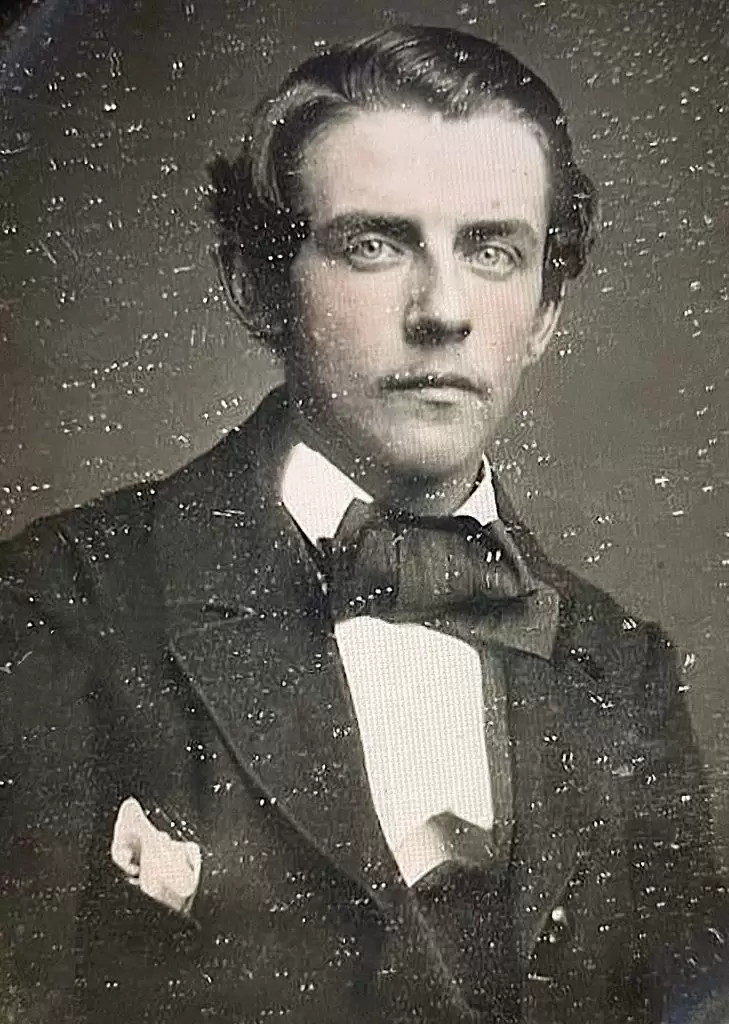




PETERS, HENRY C. (1840-1906). Corporal, 8th Regiment, New York State Militia, Company I. Peters was born in New York and served with the 8th Regiment in 1861. According to his obituary in The New York Times, he served in the Navy for five years and during the Civil War enlisted in the army, taking part in several engagements under General Ulysses S. Grant. Further details about his service are unknown although his pension record indicates that he was in the Old War Navy.
In 1889, Peters joined the G.A.R.’s Horace B. Claflin Post #578 in New York City. His application for a pension was approved in 1890, certificate 932,822. At the time of his death, from pneumonia, he was superintendent of the City Lodging House in New York City, a position he held for eight years. The obituary noted that he usually donated his salary and pension of $12 a month to the poor. His last residence was the City Lodging House at 388 First Avenue in Manhattan. In 1907, a minor’s pension was granted, certificate 735,121. Section 117, lot 7352, grave 8.

PETERSON, ERNEST A. (1843-1875). Captain, 6th New York Infantry, Company E. Peterson’s service in the Civil War as a captain in the 6th New York is inscribed on his gravestone. He last lived on Gates Avenue in Brooklyn. Peterson died of heart disease. Section 59, lot 1289, grave 120.
PETERSON (or PETTERSON), OTTO L. (1839-1912). Private, 7th Regiment, New York State Militia; 2nd Massachusetts Infantry, Company G. Born in Denmark, he first served with an unknown company of the 7th New York Militia in 1861. He then served with Company G of the 2nd Massachusetts Infantry. Further details of his military record are not specified. Peterson belonged to the Lafayette Post #140 of the G.A.R. in Brooklyn dating from September 1888. His last residence was 91 8th Avenue in Brooklyn where he succumbed to cancer. Section 155, lot 32823, grave 8.
PETERSON, RUDOLF (or RUDOLPH) (1835-1873). Adjutant, 41st New York Infantry. Originally from Germany, he enlisted on June 6, 1861, at New York City, as a sergeant major, and was commissioned into the Field and Staff of the 41st on the same day. Peterson was promoted to second lieutenant on July 30, 1861, and to adjutant on September 1, 1861. He last lived at 405 East 29th Street in Manhattan. His death was caused by typhlitis, an intestinal disease. Section 17, lot 17245, grave 1059.

PETTIT, DAVID THOMAS (1843-1927). Private, New York Light Artillery, 34th Independent Battery. Petit, who was born in New York City, enlisted at Flushing, New York, as a private on October 7, 1861, and mustered into the New York Light Artillery (34th Independent Battery) on October 16. According to his obituary in the Bayonne Times, he saw action in the following Virginia battles: Cedar Mountain, Sulphur Springs, Manassas (Bull Run), Fredericksburg, the Wilderness, and Petersburg; and at Vicksburg, Mississippi, and Knoxville, Tennessee, among others. He mustered out on October 16, 1864, at Poplar Grove Church, Virginia. In 1893, his application for an invalid pension was granted, certificate 1,108,670. His pension record indicates additional service in Company L of the New York Heavy Artillery, the company from which the 34th Independent Battery was organized. His last residence was 671 Avenue E in Bayonne, New Jersey. Section 183, lot 19897.
PETTIT, SEAMAN LEAMON (1841-1933). Private, 8th Regiment, New York State Militia, Company D. A native of Hempstead, Long Island, Pettit enlisted as a private in 1861 and served with the 8th Regiment for three months. He mustered out at the expiration of his enlistment. He was listed as a clothier in the Brooklyn Directories for 1870-1873, 1873-1876, and 1885-1886, and in the New York City Directories for 1875-1876, 1876-1878, 1882-1883, and 1891-1892. For most of those years, Pettit’s shop was at 70 Bowery in Manhattan and, after 1885, his home was on Long Island. In 1908, he applied for and received a pension, certificate 1,146,018. On November 3, 1910, he was listed in the Hempstead Sentinel as one of the large property holders in Hempstead, Long Island, with property valued at $19,300. He last lived at 179 Fulton Avenue in Hempstead, Long Island. He died of myocarditis. Section 109, lot 2959.

PFEIFFER, FERDINAND F. (1840-1909). Second lieutenant, 31st New York Infantry, Company H; private, 71st Regiment, New York State National Guard, Company A. Born in New York City, Pfeiffer enlisted as a second lieutenant there on May 21, 1861, was commissioned into the 31st New York four days later, received an official promotion to second lieutenant on July 4, and resigned his commission on August 10 of that year. On May 28, 1862, he re-enlisted as a private at New York City, mustered into the 71st New York, and mustered out at New York City after serving three months on September 21. In 1907, he applied for and was granted an invalid pension, certificate 1,135,174. His last residence was on West 131st Street in Manhattan. He died from cancer. Section 118, lot 5322, graves 9 and 10.


PFEIFFER, FREDERICK (1833-1896). Private, 5th Regiment, New York State Militia, Company C. Of German origin, he enlisted as a private at Washington, D.C., on May 16, 1861, mustered into Company C of the 5th Regiment’s State Militia on that day, and mustered out of service after three months on August 7, 1861, at New York City. His last residence was 715 Second Avenue in Manhattan. Pfeiffer died of nephritis. Section 17, lot 17245, grave 958.
PFLUGER, JOHN (1828-1918). Private, 77th Regiment, New York State National Guard, Company B. Pfluger, who was born in Germany, enlisted in 1864 and served in Company B of the 77th Regiment when it was activated for 100 days that year. His last residence was 1310 83rd Street in Brooklyn. His death was attributed to atheroma (accumulation of plaque in the arteries). Section 4, lot 33046, grave 2.
PHALON, HENRY L. (1837-1902). Private, 7th Regiment, New York State Militia, Company B. Born in New York City, Phalon served with the 7th Regiment for 30 days in 1861. His last address was 251 West 111th Street in Manhattan. In 1903, his widow applied for a pension, application 795,535, but no certificate number is listed. Section 118, lot 9906, grave 5.

PHELAN, EDWARD (1841-1876). Private, 37th New York Infantry, Company G. Born in New Hampshire, he enlisted as a private at New York City on May 29, 1862, and mustered into his company the same day. Phelan did not immediately join his regiment, was listed as furloughed on June 10, 1862, and returned on July 10, 1862. Further details are not known. He last resided at 28 South 5th Street in Brooklyn. His death was caused by drowning in the East River. Section 159, lot 13671.

PHELAN, JOHN (1816-1863). Storekeeper, United States Navy. Phelan, a native of Ireland, served as a storekeeper aboard the USS Niagara during the Civil War. Other details of his service are not known. He died of dropsy and consumption on June 4, 1863. His last address was 229 North 2nd Street in Brooklyn. Section 115, lot 4196, grave 644.

PHELPS, EDWIN C. (1838-1905). Private, 24th Connecticut Infantry, Company F. A resident of Middletown, Connecticut, he enlisted on September 6, 1862, mustered into the 24th Connecticut on November 18, and mustered out at Middletown on September 30, 1863. Phelps died from apoplexy. Section 183, lot 18982.

PHELPS, JOHN (or J. B.) (1844-1898). Corporal, 90th New York Infantry, Companies H and E. After enlisting as a private at New York City on October 1, 1861, he mustered into Company H of the 90th New York the next day, was promoted to corporal on December 27, 1862, transferred to Company E on April 7, 1863, and mustered out on October 1, 1864, at New York City. Section 68, lot 3334.

PHELPS, JR., WALTER (1832-1878). Brigadier general by brevet; colonel, 22nd New York Infantry. Born in Hartford, Connecticut, Phelps was educated at Trinity College there. His first served as a captain’s clerk in the Navy, traveled around South America to California in 1849, and engaged in mining there for a short time. He then relocated to New York where he was a lumber merchant in Glens Falls, New York. He was 5′ 10½” tall with hazel eyes and married Eliza Schenk on March 27, 1855; the couple had four daughters. During the Civil War, Phelps enlisted at Troy, New York, on May 16, 1861, and was commissioned into the 22nd New York, a regiment that he helped raise, as its colonel on June 6. The 22nd, also known as the 2nd Northern New York Regiment or the Second Troy Regiment, was raised in upstate New York and was assigned to the Army of the Potomac, I Corps, First Division, First Brigade in June 1862.
As per his biography in The Original Iron Brigade by Thomas J. Reed, Phelps commanded the 22nd New York at Camp Keyes at Upton Hill in the spring and summer of 1862 but took sick in August and returned home. Although there were rumors that his sickness was cowardice, Phelps was stung by those innuendoes and rushed back to rejoin his regiment. On September 14, 1862, Phelps assumed command of the First Brigade, also known as the Iron Brigade (later known as the “Iron Brigade of the East” to distinguish it from the better known “Iron Brigade of the West), at South Mountain and Antietam, Maryland. The Iron Brigade, consisting of four New York regiments and the 2nd U. S. Sharpshooters, was so-called for “its men made of iron” after the marches at Fredericksburg and for their “coolness, intrepidity, and stolidity under fire” according to Phelps in a letter to his wife.
Phelps’s brigade took part in the difficult climb up the face of South Mountain, driving back the relatively small portion of Brig. Gen. Robert E. Rodes’ Alabama brigade. Near the top of the mountain, Phelps’s Iron Brigade, in concert with Marsena Patrick’s brigade and supported in the rear by other elements of Abner Doubleday’s First Division, strongly confronted three under-strength Confederate brigades which were posted behind a fence across an open field. Charging the position, Phelps with his four regiments—the 2nd U.S. Sharpshooters having been detached elsewhere—“went into this action with less than 400 officers and men, and our loss on that day is a fraction less than 25 per cent.” He wrote on September 20 from Sharpsburg of the Battle of South Mountain:
“…Although the enemy were (sic) strongly posted behind a fence, and apparently in larger force than our own troops, they could not withstand the terrific fire and steady veteran advance of my line. The conflict at the fence became desperate, many of the enemy at this time being less than 8 rods in our front, but the undaunted bravery of officers and men enabled me to drive them from their position and capture a number of prisoners. The loss of the brigade at this point was much heavier than at any other on the field. Having succeeded in forcing the enemy from their position, I advanced my line about 5 rods, where I obtained partial shelter for my men from an abrupt rise of ground. Perceiving that the right of my line extended beyond the enemy’s left, I ordered 14th Brooklyn to advance their right, which being done enabled them to enfilade the enemy’s ranks with a fire which did great execution. This brigade held its position until relieved by Doubleday’s brigade. The loss in this brigade at South Mountain, Sunday, September 14 (see report of casualties already forwarded you), was as follows: Enlisted men killed, 20; commissioned officers wounded, 4; enlisted men wounded, 63; missing, 8. Total, 95. I went into this action with less than 400 officers and men, and our loss on that day is a fraction less than 25 per cent…”
At the battle of Antietam on September 17, the 14th Brooklyn was under his command when that regiment helped the 6th Wisconsin, part of the western Iron Brigade, as a Confederate charge was about to push them back through the cornfield. Colonel Rufus R. Daws of the 6th Wisconsin regiment described the incident as follows:
After moving forward the right received a deadly fire from the woods on the right and a long line of men in butternut and grey rose up from the ground. Simultaneously the hostile line opened up a terrible fire. Many fell. There was on the part of our men then intense, hysterical excitement, eagerness to go forward, reckless disregard of life, of suffering of everything but victory. The 14th Brooklyn Regiment, red legged Zouaves, came into my line on a run, closing the awful gaps. Now is the Pinch. Men and officers of New York and Wisconsin are fused together in a common mass in the frantic struggle to shoot fast. Everybody tears cartridges, loads, passes guns or shoots. Men are falling in their places or running back into the corn. The soldier who is shooting is furious in his energy and eagerness to win victory….
Phelps’s Brigade got the farthest during that action with the 14th being the only regiment to reach Dunker Church where it awaited reinforcements. At Antietam, Phelps’ brigade suffered 154 casualties, or 36 percent of those engaged.
On December 21, 1862, Major General John F. Reynolds, United States Army, singled out Phelps as deserving of special mention for his “coolness and judgment.” In his report describing the action of the First Corps, Army of the Potomac, on December 11-15, Reynolds noted the gallantry and steadiness of the troops in a brilliant attack that did not turn out as expected due to the strength of the enemy’s defenses. Phelps mustered out on June 19, 1863, at Albany, New York. Although recommended for brigadier general by his senior officers in the winter of 1862-1863, in letters to President Lincoln, that promotion never materialized; as per Thomas J. Reed, none of the letters recommending Phelps for promotion are in the Lincoln archives leading to speculation that the letters were never received by the President. The senior officers who recommended him were Brigadier General Rufus King, Brigadier General John Hatch, Major General John Reynolds and Major General Joseph Hooker. His biographical sketch notes that he commanded the Iron Brigade longer than any other commander and also saw action at Fredericksburg and Chancellorsville. Phelps was brevetted brigadier general of United States Volunteers on March 13, 1865, “for gallant and meritorious services.”
An iron manufacturer after the Civil War, he last lived in Millerton, New York, but died in Bennington, Vermont, while on a business trip to visit a foundry. The Troy Times, which stated incorrectly that he served throughout the Civil War, noted in his obituary that he was well-respected in the community and was a man of rare scholastic achievements and firmness of purpose. Section 153, lot 20820.
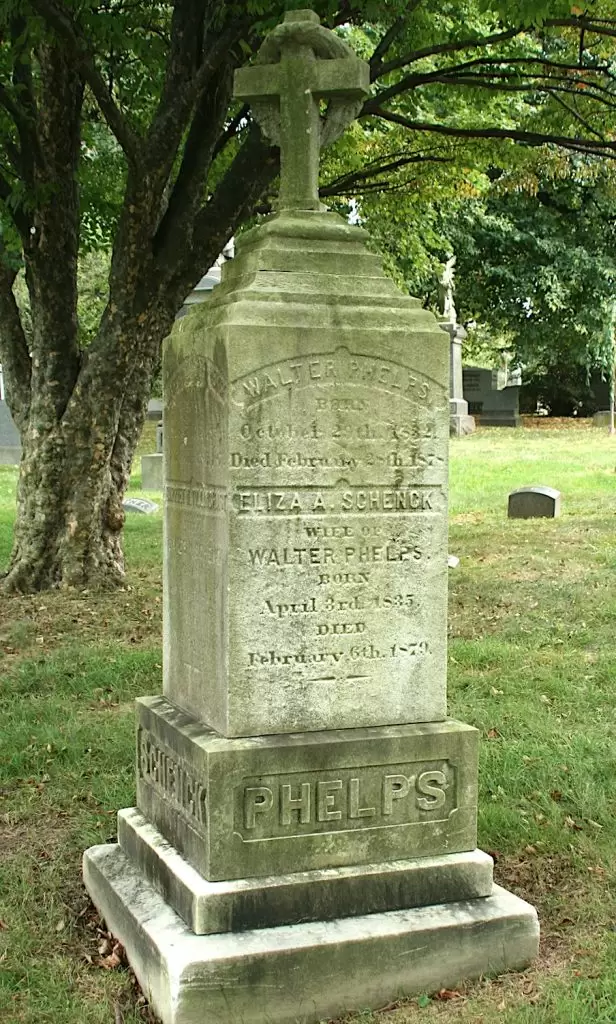
PHILIP (or PHILLIP), BENJAMIN D. (1834-1868). Second lieutenant, 84th New York (14th Brooklyn) Infantry, Companies K and D; private, 71st Regiment, New York State Militia, Company G. In 1861, he served for three months with the 71st Regiment and was wounded at First Bull Run, Virginia, on July 21, 1861. After Phillip mustered out, he re-enlisted as a second lieutenant on an unknown date, mustered into Company K of the 14th Brooklyn but was not commissioned, and later served as a commissioned second lieutenant with Company D prior to mustering out. His last residence was on Franklin Avenue in Brooklyn. His death was caused by apoplexy. Section 96, lot 153.

PHILIPS, CHARLES S. (1844-1907). Second lieutenant, 169th New York Infantry, Companies C and B. After he enlisted as a corporal at Brunswick, New York, on September 6, 1862, Philips mustered into Company C of the 169th a month later on October 6. He rose to sergeant and first sergeant on unstated dates, to second lieutenant on April 1, 1865, and transferred to Company B four days after his last promotion. On July 19, 1865, he mustered out at Raleigh, North Carolina. His application for an invalid pension was granted in 1869, certificate 105,696.
A tobacconist by trade, Philips held many patents by 1881 including those related to a vapor burner, curing and coloring tobacco; treating tobacco; maturing, sweating, and coloring leaf-tobacco; aging and maturing coffee; aging and improving the quality of coffee; and maturing coffee. According to the Brooklyn Directory for 1888-1890 and the 1900 census, he was living at 251 Macon Street and still was employed as a tobacconist. Section 133, lot 16874.
PHILIPS, GEORGE A. (1831-1885). Private, 6th New York Heavy Artillery, Battery K. Born in the Bronx, New York, Philips enlisted at West Farms (Bronx), New York, as a private, on August 20, 1862, and mustered into the 6th Heavy Artillery on September 2. He was discharged on May 9, 1865, at Harper’s Ferry, West Virginia. His last residence was 265 Lexington Avenue in Manhattan. Section 118, lot 1774.
PHILLIPS, GEORGE W. (1845-1884). Corporal, 158th New York Infantry, Company D. Phillips’s birthplace is uncertain; one record indicates that he was born in Ireland and another states that he born in New York. During the Civil War, he enlisted as a corporal at Brooklyn on August 16, 1862, and mustered into the 158th on August 31. Phillips spent most of his service near New Berne, North Carolina. He was wounded at Petersburg, Virginia, on September 30, 1864, and was discharged from Whitehall Hospital in Philadelphia, Pennsylvania, on May 18, 1865. He last resided in New York. His death was caused by pneumonia. Section 64, lot 4071, grave 521.
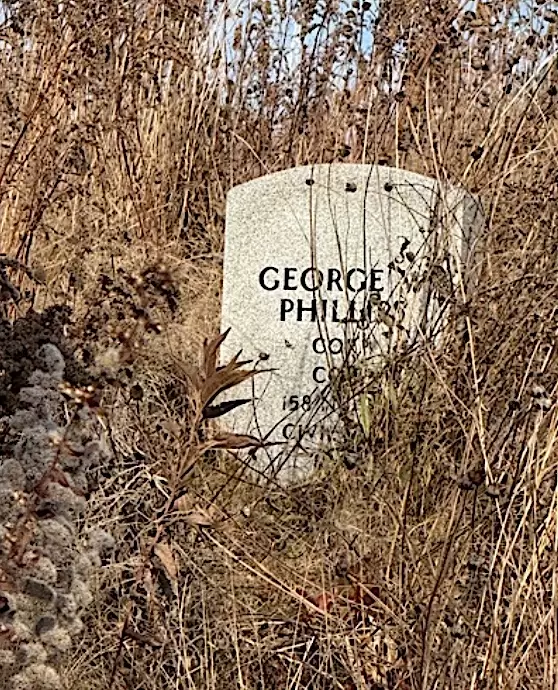
PHILLIPS, ISAIAH (1838-1878). Private, United States Colored Troops. According to his Find A Grave listing, he served as a private in the United States Colored Troops. However, no listing for him, in either the Historical Data Systems or the National Parks Service Soldiers and Sailors Database, is apparent. In any event, the Isaiah Phillips who is interred at Green-Wood was likely born in 1838 and died in 1878. In the 1850 federal census, Isaiah Phillips is listed as a 13-year-old Black man living in New York City with his parents, George and Eliza, and two brothers. As per the 1862 Brooklyn Directory, Isaiah Phillips was a “col. porter”—ostensibly colored porter. By 1870, the census has him living in New York City, a 33-year-old Black man still working as a porter, with his mother’s name as Elisa. According to Green-Wood’s chronological book entries, he died at New York “Colored Home” of hepatitis. Section 64, lot 4473.
PHILLIPS, PHILIP A. (or W.) (1840-1907). Private, 13th Regiment, New York State National Guard, Company A. Born in New York City and a jeweler by trade, Phillips enlisted as a private in 1863 for a period of 30 days and mustered into the 13th Regiment. He was a member of the G. K. Warren Post #286 of the G.A.R., which he joined in 1883. At the time of his death from peritonitis, he lived at 235 Chauncey Street, Brooklyn. Section 121, lot 14114, grave 5.

PHILLIPS, REUBEN (1827-1885). First sergeant, 6th Regiment, New York State Militia, Company A; private, 106th New York Infantry, Company I. A New York City native, Phillips served for three months with the 6th Regiment in 1861. Although no notation is given for his rank at the time he mustered in, soldier records indicate that he mustered out as a first sergeant. He re-enlisted as a private at Goshen, New York, on September 27, 1864, and mustered into the 107th New York on October 6. According to his muster roll, he was employed as a clerk and was 5′ 7½” tall with blue eyes, light hair and a fair complexion. Phillips mustered out with his company on June 22, 1865, at Washington, D.C. In 1890, Jane Phillips applied for and received a widow’s pension, certificate 337,884. Section 13, lot 19694.
PHILLIPS (or PHILP), WILLIAM H. (1827-1886). First lieutenant, 1st New York Mounted Rifles, Companies H, E, and F. A native of England, he enlisted as a private at New York City on July 24, 1862, and mustered into Company H of the 1st New York Mounted Rifles. He rose through the ranks to quartermaster sergeant on August 13, 1862, and was promoted to first lieutenant on March 6, 1863, effective upon his transfer to Company E. He joined the Field and Staff on May 19, 1863, returned to Company F as a first lieutenant on December 22, 1864, and mustered out on July 21, 1865, at Richmond, Virginia. He last resided at 423 West 34th Street in Manhattan. Section 174, Lot 18232.
PHILLIPS, WILLIAM H. H. (1840-1921). Private, 1st New York Cavalry, Company D. Born in Southampton, Long Island, Phillips enlisted at New York City on July 16, 1861, and immediately mustered into the 1st New York Cavalry. He was discharged for disability on November 2, 1861, at Camp Meigs. In 1901, he applied for an invalid pension, application 1,270,429, but there is no certificate number. His last residence was the Central Islip State Hospital, a mental health facility, where his death was attributed to arteriosclerosis. Section 74, lot 10661.
PHIPPS, JOHN M. (1833-1902). Private, 7th Regiment, New York State National Guard, Company G. Originally from Stratford-on-Avon, England, Phipps was a great admirer and scholar of Stratford’s most famous citizen, William Shakespeare. He enlisted as a private on May 25, 1862, at New York City, mustered into the 7th Regiment on that day, and mustered out at New York City on September 5, 1862. His obituary in the Brooklyn Daily Eagle notes that he served throughout the hostilities and was a veteran of twenty-five battles, receiving special mention for his bravery in the Battle of Lookout Mountain, Tennessee.
After the Civil War, Phipps was a wallpaper salesman and was active in the Republican Party in Ohio and Brooklyn. Through his political activism, he made personal friendships with Presidents Lincoln and Garfield. Although he spent much time in Ohio after the War, his last residence was 415 Putnam Street in Brooklyn. He died from diabetes. Section 194, lot 31415.
PHIPPS, WILLIAM T. (1827-1888). Private, 63rd New York Infantry, Company B. A native of Brooklyn, he enlisted at New York City on August 14, 1861, mustered into the 63rd that day, and deserted on November 28 of that year. His last address was 556 Monroe Street in Brooklyn. Section 161, lot 14865.

PHYFE, WILLIAM MIDDLETON (1810-1893). Corporal, 82nd New York Infantry, Companies A and E; Veteran Reserve Corps; 7th New Jersey Infantry, Company B. A nephew of renowned furniture maker, Duncan Phyfe, he was born in Washington, D.C., and earned a living as a silversmith in Boston, Massachusetts, and later, in New York City. In 1834, he married Elizabeth Crooker; she died in 1837. Phyfe married Elizabeth’s sister, Rachel Crooker, in 1838, they had four children. An adventurer, Phyfe went by ship to Sutter’s Mill, California, during the Gold Rush, and returned to New York City and his business in 1852.
At age 51, Phyfe enlisted at New York City as a private on May 21, 1861, mustered into Company A of the 82nd New York, was promoted to corporal, and transferred to Company E on July 15, 1861. On February 15, 1864, he transferred to the Veteran Reserve Corps from which he was discharged on an unknown date. According to a descendant, he fought in many famous Virginia battles including Fairfax Court House, Bull Run, Goose Creek, and Fredericksburg. He re-enlisted as a private on September 20, 1864, mustered in that day as a substitute in the 7th New Jersey, rose to corporal on December 18, 1864, and mustered out at Washington, D.C., on June 4, 1865. In 1885, his application for an invalid pension was granted, certificate 490,283. A widower, he last resided at 72 Jane Street in Manhattan. Section 173, lot 21601, grave 1.
PICKENS, NICHOLAS B. (1834-1863). Private, 5th New York Infantry. Pickens, who was born in New Jersey, lived at 382 Cherry Street in New York City at the time of his enlistment. He enlisted at New York City as a private on August 23, 1862, and mustered into an unassigned company of the 5th New York two days later. On February 11, 1863, he died of typhoid fever at Campbell Hospital in Washington, D.C., and was interred at Green-Wood on March 10, 1863. Section B, lot 9895, grave 723.

PICKERING, JOHN (1829-1861). Unknown soldier history. He was born in England and his last residence was in Brooklyn. He died of pneumonia at Sandy Hook. A marble Veterans Administration stone was ordered for him early in the 21st century. Section 115, lot 13536 (Soldiers’ Lot), grave 53.
PICKETT, JOHN MELANCTHON (1839-1923). Private, 6th New York Cavalry, Company A. A plate engraver by trade, Pickett enlisted on August 20, 1862, at Brooklyn, and mustered immediately into the 6th New York Cavalry. He fought at the Battle of Chancellorsville, Virginia, was taken as a prisoner of war, and then returned to his regiment. Pickett mustered out on June 5, 1865, at Cloud’s Mills, Virginia.
In 1867, Pickett married Ellen Lunderkin. At the time of the 1870 census, he and his wife and two young children were living in Washington, D.C., where he was a printer for the United States Treasury. By the time of the 1880 census, he was living in Brooklyn with his wife, three children and his mother; he was recorded as living in Brooklyn in 1892, 1900 and 1905. A widower in 1910, he lived with his daughter, Lillian, and her family in Sharon, Massachusetts. In 1920, he lived with his daughter, Sarah, and her family in Milford, Pennsylvania. His last residence was 131 1st Street in Woodhaven, Queens. His death was attributed to arteriosclerosis. Section 85, lot 1594, grave 238.
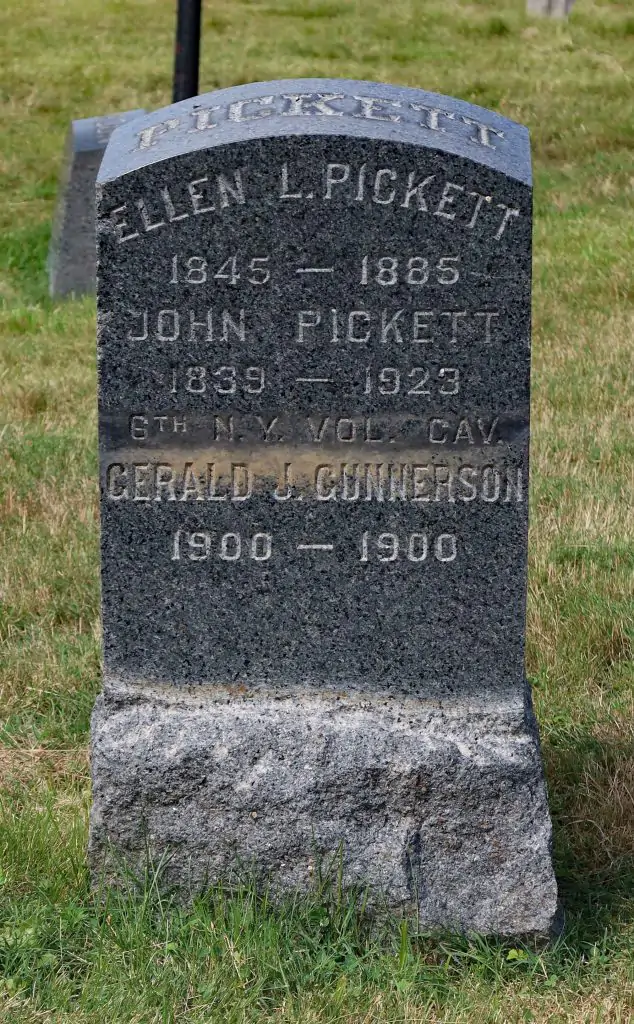

PIDGEON, ROBERT R. (1840-1910). Corporal, 71st Regiment, New York State National Guard, Company I. After enlisting at New York City and mustering into the 71st as a corporal on May 28, 1862, he mustered out after three months on September 2 at New York City. He died of heart disease. His tombstone bears the inscription, “He fought the good fight. Faithful and true.” Section 2, lot 5499.
PIERCE, HENRY D. (or H. D.) (1846-1925). Private, 7th Vermont Infantry, Company G. Pierce was born in Cavendish, Vermont. As per the census of 1860, he lived in Cavendish with his parents and older sister. During the Civil War, Pierce enlisted as a private on August 19, 1864, mustered immediately into the 7th Vermont, and mustered out on July 14, 1865.
The 1880 census lists Pierce as a marble dealer who was married and lived in Toledo, Ohio. In 1898, he applied for admission to the Sons of the American Revolution, stating that he was a descendant, on his mother’s side, of David Fiske, a soldier known as “Fifer David” who served at Lexington, Massachusetts, in Colonel Timothy Bigelow’s regiment. The 1900 census, which reports that he had been married for twenty-five years, indicates that he was the manager of a marble company and lived in Cicero, Illinois, with his wife and adult daughter and teen-age son. According to the census of 1910, he was still managing a marble company, lived in Oak Park, Illinois, with his wife and adult children, and was a Union veteran. At the time of the 1920 census, he lived on Madison Avenue in Manhattan with his wife and adult daughter, and had retired from his job. Helena Elizabeth Pierce, his daughter, who was born in Toledo, Ohio, was a member of the Daughters of the American Revolution, tracing her lineage to her great-great-grandfather. Section 32, lot 7669.
PIERSON (or PEIRSONS), HENRY MORSE (1837-1915). Corporal, 12th Vermont Infantry, Company C. A Vermont native, Pierson was born in Shelburne and resided in Burlington where he enlisted as a corporal on August 23, 1862. He mustered into Company C of the 12th Vermont on October 4, and was discharged on July 14, 1863, at Brattleboro, Vermont. After the War, he was a Brooklyn resident for more than 50 years and was president of a Manhattan company that manufactured by-products from coal. In addition, he belonged to the Winchester Post #197 of the G.A.R. He successfully applied for an invalid pension in 1890, certificate 1,080,622. His last residence was 81 Macon Street in Brooklyn, but he died at his summer home in Westfield, New Jersey. Frances Pierson, who is interred with him, received a widow’s pension shortly after his death in 1915, certificate 802,002. Section 152, lot 19171, grave 1.
PILCHER, LEWIS STEPHEN (1845-1934). Hospital steward, Union Army. Pilcher, who was born in Adrian, Michigan, earned a bachelor’s degree from the University of Michigan in 1862, at age 16, the youngest graduate in the history of the university. At age 17, he earned his master’s degree. After serving as a hospital steward for the Union Army from 1864 through September 1865, Pilcher returned to the University of Michigan and earned his medical degree in 1866.
As per his obituary in the Brooklyn Daily Eagle, which confirmed his service as a hospital steward, Pilcher briefly served as a house surgeon at the Harper Hospital in Detroit before coming to New York for post-graduate studies. In addition to practicing medicine, he was a schoolteacher in rural areas of his home state. He had a five-year tour of duty as an assistant surgeon in the Navy, and in 1872, began his medical career in Brooklyn, the hometown of his wife. Dr. Pilcher was a prominent surgeon, author and teacher for 68 years. He had a dissecting room in his house that expanded in conjunction with a library and museum. In 1872, he was appointed as one of the attending physicians of the Central Brooklyn Dispensary and became a surgeon associated with the Long Island College Hospital a year later. Dr. Pilcher was a Lecturer in Anatomy at the Long Island College Hospital. From 1879-1882, he was an Adjunct Professor of Anatomy at the Long Island College Hospital and then became a Professor of Clinical Surgery at the New York Post Graduate Medical School from 1885-1895. In 1881, Pilcher was one of the incorporators of the Methodist Episcopal Hospital in Brooklyn, was a member of its board of managers from its inception and became president of its medical board from 1887 through 1907.
Beginning in 1884 and continuing throughout his lifetime, Pilcher was the editor of The Annals of Surgery, a monthly publication, and was a member of the New York State Board of Medical Examiners beginning in 1913. A commander of the Ulysses S. Grant Post #327 of the Grand Army of the Republic (G.A.R.), he was an advocate for patriotism in the schools and military surgery for doctors. On May 13, 1916, an article the Brooklyn Standard Union noted that Dr. Pilcher was honored at a golden jubilee at the Hotel Bossert commemorating 50 years of service as a physician. He received a gold medal that recognized his devotion to medicine and to his patriotism and literary efforts. The 500 attendees heard tributes and telegrams from throughout the world. Dr. Pilcher stirred the emotions of the crowd when he spoke of his Naval service, praised his colleagues in Brooklyn’s medical fraternity, and urged those in attendance to “keep the Civil War spirit of patriotism burning.” In 1921, he was elected commander-in-chief of the G.A.R. at its 55th annual meeting, after serving as head of the G.A.R. in New York. He was also active in medical and surgical organizations serving in many leadership positions including the presidency of the Kings County Medical Society in 1900.
As per his obituary in the Brooklyn Daily Eagle, he was at the time of his death, the oldest surgeon and the oldest editor in terms of service in the United States. His son, also a physician, belonged to the Sons of Union Veterans. He died at age 89 of arteriosclerosis at his residence, 179 Cooper Avenue, Upper Montclair, New Jersey. His funeral took place at the Fairchild Chapel at 86 Lefferts Place in Brooklyn. Newspapers in Ann Arbor, Detroit, and Cold Spring, Michigan, were asked to print his obituary. Section 109, lot 15729.






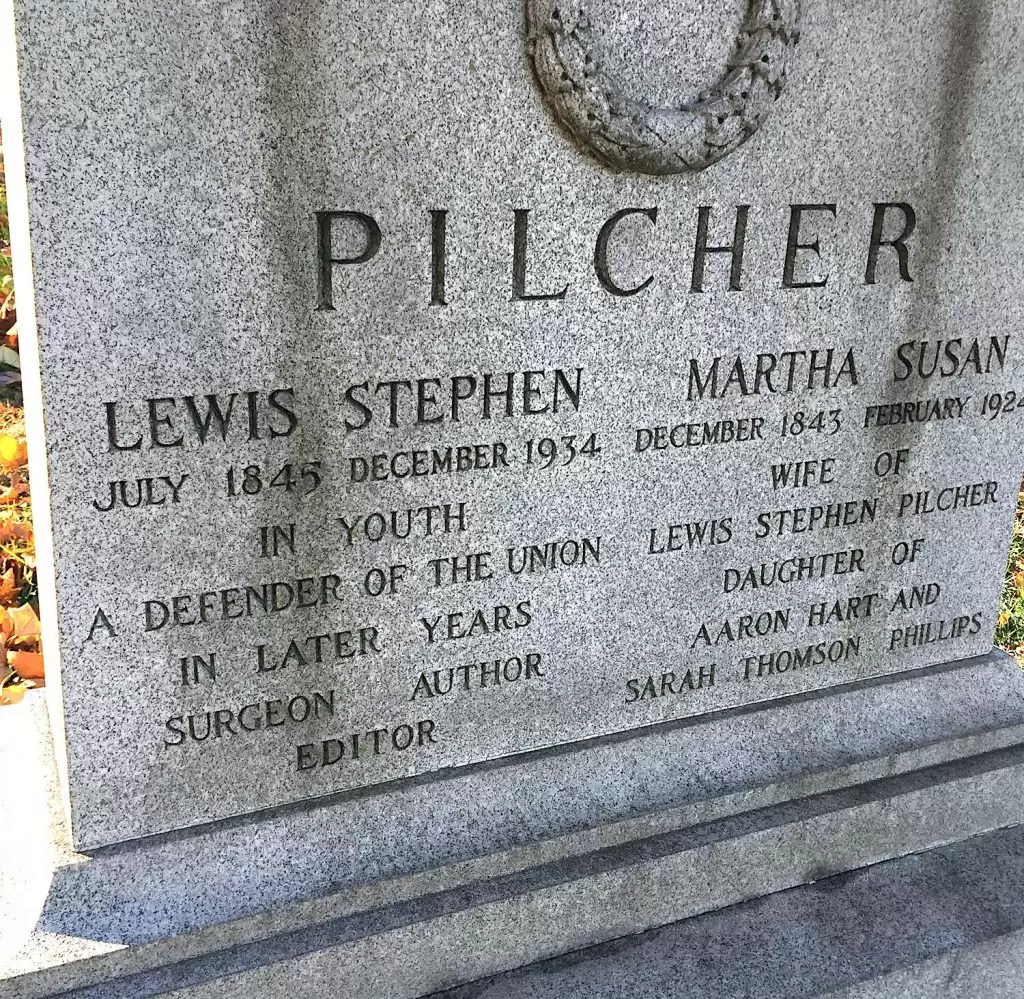

PILSWORTH (or PILLSWORTH), DAVID J. (1841-1895). Captain, 20th United States Colored Troops (USCT); private, 44th New York Infantry, Company I. On October 12, 1861, he enlisted and mustered into the 44th at Albany, New York. Pilsworth was discharged and commissioned as a first lieutenant in the 20th Regiment of the USCT on December 8, 1863, one of three units of African-American soldiers in New York State stationed at Rikers and Hart’s Islands. (Privates in the USCT were African-American, officers were white.) He was a captain at the time of his discharge; that rank is inscribed on his tombstone. Section 199, lot 29029.

PINCKNEY (or PICKNEY), JOSEPH CONSELYEA (1821-1881). Brigadier general and major by brevet; colonel, 6th Regiment, New York State Militia; 66th New York Infantry; captain and commissary of subsistence, United States Volunteers. Born in New York City, his father, Peter Pinckney, was a prosperous grocer who owned real estate and co-founded the Bowery Fire Insurance Company. This enabled Joseph Pinckney to lead a comfortable life until 1841 when his father died suddenly at a time when his credit was over-extended. Joseph Pinckney was also a commanding officer of the 6th New York Militia as of 1856.
In addition, Pinckney played baseball in the early days of organized teams and was recruited by a baseball club in Morrisania, named the Unions, probably as a political statement. In 1855, he played for the Unions of Morrisania, then over the Unions’ objections that he was still a member of their team, played for the Gothams in 1856 and 1857. An article about that “two-timing” by Pinckney was first published in Porter’s Spirit of the Times on September 18, 1856, and cited in Thomas Gilbert’s Playing First: Early Baseball Lives at Brooklyn’s Green-Wood Cemetery (2015, pp. 338-39). In a ball game against the Knickerbockers, Pinckney, who was thought to be a member of the Union team, appeared in the Gotham’s line-up as their second baseman. The article posed the possibility that he was a “fancy character” or “outside friend,” a new face in the line-up after gamblers had set odds for the game. Although Pinckney claimed “innocence,” he was one of the best players in the game and had played for the Unions on August 27, played the one big game for the Gothams on September 5, then returned to the Unions on September 17. Although the answer as to whether Pinckney was a “ringer” is unknown, what is known is that there were no rules in place against playing for two teams; the National Association of Base Ball Players was established in 1858 to regulate inter-club competitions. He returned to the Unions in 1858 as a second baseman when he was one of three New York players selected for the Fashion Race Course match between New York City and Brooklyn who played in all three games. That match marked a turning point in American baseball–it was the first all star game, the first time admission to a baseball game had been charged, and the first time that a game was played on an enclosed field–making the home run hit out of bounds possible. In 1859, he was a clerk in the Finance Department and later became manager of the Bureau of Arrears. Active in the Republican Party, Pinckney was a member of the 1860 Chicago Convention which nominated Abraham Lincoln.
At the onset of the Civil War, Pinckney left the Controller’s Office and enlisted at New York City on April 19, 1861, and was commissioned into the 6th New York State Militia as its colonel on May 14. As per an article on his death in The New York Times on March 12, 1881, the 6th was detailed to Annapolis, Maryland, a major supply post, and Pinckney was placed in command of that city. He mustered out after three months on August 31 at New York City. On November 4 of that year, he re-enlisted and was commissioned as colonel of the 66th New York Infantry, a regiment that he recruited. Leading the 66th at Fair Oaks, Virginia, Pinckney was praised by the commanding officer, Brigadier General William French, in his field report of June 3, 1862, for flanking the enemy on the left and ultimately causing their retreat. He was also complimented for his gallantry at Gaines’s Mills and subsequently brevetted to brigadier general for his actions there. He was discharged on December 3, 1862. The New York Times article notes that he resigned because he was incapacitated by sickness (liver disease) contracted while in service. During his time with the 66th, he saved a runaway slave by hiding him from his pursuers in a military field hospital. Although physically unfit for combat duty, Pinckney chose to continue to serve the Union in non-combat duty. On March 11, 1863, he was commissioned into the United States Volunteers Commissary Department as captain and commissary of subsistence in Buffalo, New York, and remained there throughout the War. He was brevetted major and brigadier general of volunteers on March 13, 1865, for his War service, and mustered out on February 21, 1866.
Pinckney spent time in Europe to restore his health, then returned to New York in 1867, at which time he resumed his interest in Republican Party politics. Pinckney had been a delegate to all state and county Republican Party conventions after the Civil War. He was appointed clerk of the Board of Alderman in 1873, and served in that position for two years before he was elected alderman from the Sixth District in 1885, a previously Democratic district. He then was elected alderman-at-large, served from 1876-1878, then was elected chairman of the Republican Central Committee in 1878. He was listed as an alderman in the 1877 New York City Directory. Pinckney was appointed Commissioner of Emigration in 1880, and was chairman of the Ward’s Island Committee. He helped process new immigrants, provide them with medical and psychiatric care, shelter homeless immigrants, and protect them from exploitation. Remaining active in military affairs, he was a member of the Cameron Post #79 of the G.A.R., was its commander for three years, and was chairman of the Memorial Committee of the organization in 1875-1876. In addition, he was a Freemason, member of the Knights of Templar, Independent Order of Odd Fellows, and Benevolent Order of Elks, giving the oration for that organization at the unveiling of a monument at Evergreen Cemetery.
Known as a “bon vivant,” Pinckney was interested in the theater and actresses and was among the fans of Sarah Bernhardt who studied her intonations and gestures. According to The New York Times, he had a library that was rich in books related to New York City politics. His death was attributed to a “torpid liver” that had troubled him for some time dating back to his Civil War service. He last resided at 27 Stuyvesant Street in New York City. As per Gilbert, Pinckney left his house and its furnishings to his faithful housekeeper, Annie Benson. He also owned brownstones on East 122nd Street in Manhattan, leaving one to an infant, Joseph Conselyea, thought to be his son by a 25-year-old servant who lived in a nearby rooming house. He died of cirrhosis. Section 26, lot 7194.

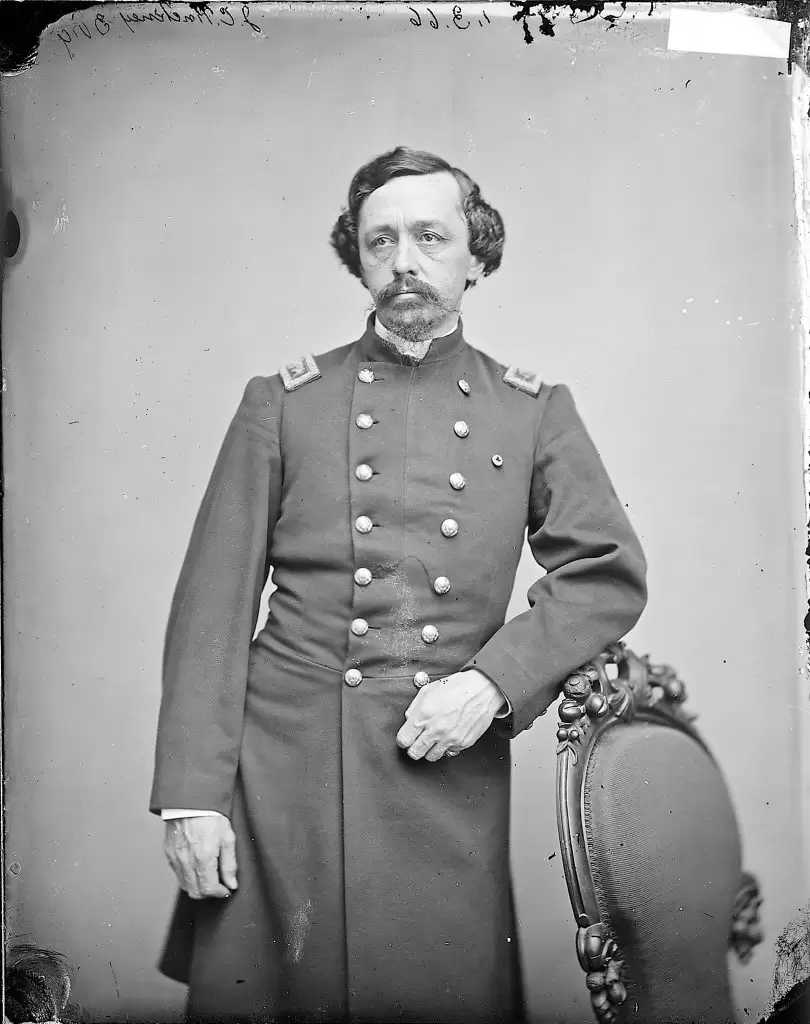


PINE, JOHN HENNING (1847-1902). Private, 7th New York Veteran Infantry, Company B. A native of New York City, Pine enlisted there as a private on March 22, 1865, and mustered in the same day. His enlistment papers note that he signed up for one year, agreed to accept bounty, pay and clothing established by law for volunteers, and swore his allegiance to the United States of America,“…I will serve them honestly and faithfully against all their enemies or opposers whomsoever….”As per his muster roll, he was a clerk who was 5′ 6″ tall with brown eyes, brown hair and a light complexion. The 7th Veterans fought in the Appomattox campaign in Virginia in 1865. The muster roll notes that he was absent and sick on June 30, 1865. He was admitted to Armory Square Hospital at Washington, D.C., on June 2 and was discharged from the hospital on July 3, 1865. Armory Square Hospital was noteworthy because it was built in 1862 as a model hospital according to the guidelines of the United States Sanitary Commission. In addition, that facility recorded the largest number of soldier deaths of any Washington military hospital. His papers at muster out indicate that he was paid a bounty of $33.33, and had settled his clothing account.
Pine remained in the nation’s capital where he worked as a United States Army hospital steward from February 12, 1866 through February 12, 1869, and again from May 27, 1869 through May 1, 1872. At the time of his death, he worked as a bookkeeper. An article in the Brooklyn Daily Eagle on October 20, 1902, recounted the strange nature of his death. Apparently, he had suffered from delirium after sustaining injuries from a fall the month before his demise. On the morning of his death, while in a delirious state and not under his wife’s watchful eye, he walked out of a second story window and fell about thirty feet into his front yard incurring internal injuries and a fractured skull that resulted in his death three hours later. He last lived at 22 Rutledge Street in Brooklyn. Section 17, lot 17245.



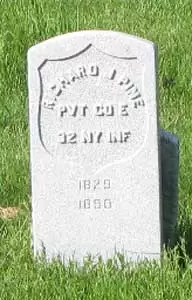
PINE (or PEINE), RICHARD J. (1829-1890). Private, 32nd New York Infantry, Company E. After enlisting as a private at New Dorp, Staten Island, on May 14, 1861, he mustered into the 32nd New York on May 31, and was discharged for disability on September 11 of that year at Camp Newton, Virginia. His last address was 1151 Bedford Avenue in Brooklyn. Pine succumbed to emphysema. Section 206, lot 21347, grave 114.
PINKERTON, TEENAN (or THOMAS) (1836-1886). Corporal, 139th New York Infantry, Company D. Pinkerton was born in Ireland. His birth year is unclear; Green-Wood records and a family tree indicate 1836 but his G.A.R. sketchbook reports that he was born in 1843 and his soldier record indicates a birth year of 1834. During the Civil War, he enlisted as a private on August 26, 1862, and mustered into Company D of the 139th New York on September 9. He was promoted to corporal on December 2, 1862, and mustered out with his company on June 19, 1865, at Richmond, Virginia.
Pinkerton married Esther Fry in Brooklyn on October 22, 1869; the couple had six children. On March 2, 1884, Pinkerton mustered into the Frank Head Post #16 of the G.A.R.; he noted in that organization’s sketchbook that he lived in Brooklyn and worked as a porter. Although he applied for an invalid pension on March 15, 1884, he died before it was certified. Pinkerton was a deacon at the Good Shepherd Church at 7420 Fourth Avenue in Brooklyn; his wife was president of the Women’s Society at that church. He last lived at 105 Luquer Street in Brooklyn. He succumbed to consumption. Esther Pinkerton applied for and received a widow’s pension, certificate 327,359. Section 15, lot 17263, grave 704.

PINKHAM, HENRY (1825-1862). Sergeant, 4th New York Infantry, Company B. He enlisted on April 22, 1861, at New York City, as a sergeant, mustered in on May 9, and was promoted to first sergeant on May 15, 1862. Pinkham was killed on the battlefield at Antietam, Maryland, on September 17, 1862, and interred at Green-Wood on November 29, 1862. Mary Pinkham applied for and received a widow’s pension, certificate 2,605, as did a minor, certificate 43,782. A marble Veterans Administration stone was ordered for him early in the 20th century. Section 115, lot 13536 (Soldiers’ Lot), grave 43.
PINKNEY, FREDERICK HAWS (1835-1911). Private, 7th Regiment, New York State National Guard, Company G. Enlisting and mustering in at New York City on May 25, 1862, he mustered out there with his regiment on September 5, 1862. He last lived at 27 West 127th Street in Manhattan. Pinkney died of angina pectoris. Section 114, lot 16572.

PINKNEY, JAMES H. (1840-1920). Artificer, 3rd New York Light Artillery, Battery M. A native of New York City, he enlisted there as an artificer on May 28, 1862, and mustered into Battery M of the 3rd New York Light Artillery. When he mustered out, his rank was that of private. His last residence was 37 Franklin Street in Jamaica, Queens. Section 114, lot 16572.
PINTO, ENLENTHERIO (or ELENTHERO) (1822-1895). Corporal, 8th Regiment, New York State Militia, Company B. Originally from Portugal, Pinto served in the 8th Regiment for three months in 1861, entering as a private and mustering out with the rank of corporal. He was a member of the George C. Strong Post #534 of the G.A.R. in Brooklyn. In 1882, he filed for and received an invalid pension, certificate 393,408. His last address was 231 Nassau Street in Brooklyn. He died of apoplexy. Section 137, lot 29048, graves 1 and 2.
PINTO, FRANCIS EFFINGHAM (1823-1905). Brigadier general by brevet; colonel, 31st New York Infantry; 32nd New York Infantry. Born in New Haven, Connecticut, he served with the 1st New York during the Mexican War engaging in the Battles of Vera Cruz, Cerro Gordo and Chapultepec. Pinto, a clerk, was 5′ 9″ with blue eyes and dark hair. At age 35, he enlisted at New York City on May 22, 1861, and was commissioned into the 32nd New York nine days later as its lieutenant colonel. On December 2, 1861, Brigadier General John Newton, United States Army, in his field report from Annandale, Virginia, commended Pinto for “…great coolness, decision, and prudence” in an emergency situation when he led a company from his pickets to support men who had been engaged in a skirmish at Fairfax Courthouse, Virginia.
Promoted to colonel on October 3, 1862, Pinto commanded the 31st and 32nd in Virginia at the Seven Days’ Battle from June 25-July 2, 1862, including Gaines’ Mill on June 27, 1862, and at the Battle of Crampton’s Pass, Maryland (South Mountain) on September 14, 1862. As commanding officer in the latter battle, he wrote about the attack there two days later, “…I remained in this position until I saw the troops on my right moving forward, when I instantly gave the order to charge, which was promptly obeyed by jumping a fence and passing through a corn-field with an unearthly yell. The enemy before us broke, and fled right and left….” Brigadier General John Newton, United States Army, once again cited his actions, this time at Crampton’s Pass, in his field report dated September 24 of that year. Subsequently, Pinto led both regiments at the Battle of Antietam, Maryland. He commanded the 32nd at the action at Franklin’s Crossing, Virginia (Deep Run), from April 29-May 2, 1863, and at the Battles of Fredericksburg and Salem Church, Virginia, from May 3-4, 1863. He mustered out on June 9, 1863, at New York City. On March 13, 1865, he was brevetted brigadier general “for meritorious services during the War.”
When he returned to civilian life, he was a merchant engaged in the grain warehousing business. In 1888, Pinto applied for a pension based on his service in the Mexican War, claim number 18,133. His last residence was 105 State Street in Brooklyn. His death was caused by pneumonia. His widow, Gertrude Pinto, received a pension in 1908, certificate 647,201, citing her husband’s service in both the Mexican and Civil Wars. Section 99, lot 5946.
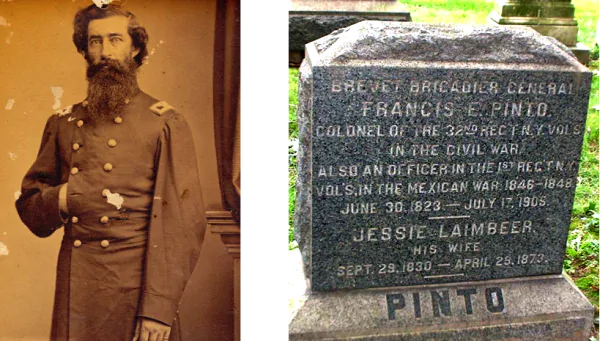




PIPER, FREDERICK H. (or W.) (1843-1905). Private, 71st Regiment, New York State Militia, Company C. After enlisting in 1861, Piper served for three months with the 71st Regiment. In 1901, his application for a pension was granted, certificate 1,098,627. His G.A.R. membership is inscribed on his tombstone. He last lived in Manalapan, New Jersey. His death was caused by hemiplegia, a paralysis of half the body. His wife applied for and received a widow’s pension, certificate 598,340. Section 78, lot 5144, grave 13.
PIPER, GEORGE (1822-1894). Corporal, 3rd Massachusetts Cavalry, Company L. A New York native, Piper was a bricklayer and resident of New Orleans, Louisiana, when he enlisted there as a private on June 1, 1862, and mustered into Company L of the 3rd Massachusetts. He was promoted to corporal on October 1, 1864, then reduced to ranks (private) on January 1, 1865. He mustered out on May 21, 1865. Piper’s pension index record shows that he also served in Company H of the 3rd Massachusetts Cavalry but the transfer dates are not specified. The 1882-1883 New York City Directory lists him as a bricklayer. In 1890, his application for an invalid pension was approved, certificate 587,036. The cause of his death was listed as “diarrhosis.” He last lived at 346 West 12th Street in Manhattan. Susan Piper applied for and was awarded a widow’s pension in 1894, certificate 418,905. Section 140, lot 23416, grave 4.


PITTMAN, JR., LEMUEL (1839-1887). Second lieutenant, 31st New York Infantry, Company G. After enlisting at New York City as a private on May 13, 1861, he mustered into the 31st New York two weeks later. He was promoted to quartermaster sergeant on September 12, 1861, and rose to second lieutenant on March 3, 1863, but did not muster in that rank. He mustered out on February 22, 1863. According to the 1880 census, he was employed as a packing box maker. He last lived in New York City where he died from cirrhosis. Section 175, lot 11598.
PLACE, CHARLES A. (1840-1879). Captain, 15th New York Engineers, Company F. It is most likely that Place is not buried at Green-Wood. No record of his burial at Green-Wood has been found; it appears that his monument is a cenotaph. Place enlisted at Camp St. John as a second lieutenant on August 10, 1861, and was commissioned into Company F of the 15th New York Engineers on that date. He was promoted to first lieutenant, Company H, on November 1, 1862, and to captain on January 9, 1863. His monument at Green-Wood Cemetery indicates that he took part in these Virginia battles: Yorktown, Seven Pines, and Malvern Hill, all of which were a part of the Peninsula Campaign of 1862. Section 159/162, lot 14464.
PLACE, THOMAS C. (1840-1901). Musician, 8th Regiment, New York State National Guard, Company A. A New York City native, he enlisted in 1862 for 30 days as a musician. His last residence was 309 West 112th Street in Manhattan. His death was attributed to nephritis. Sarah A. Place applied for and was granted a widow’s pension in 1901, certificate 573,359. Section 145, lot 26568, grave 3.

PLATT, CHARLES A. (1827-1867). Private, 6th New York Heavy Artillery, Company H. A New York State native, Platt enlisted as a private at Morrisania, New York, on August 20, 1862. On September 2, he mustered into Company H of the 6th Heavy Artillery from which he was discharged for disability on May 20, 1863, at Maryland Heights, Maryland. His last address was Montgomery Street, in Jersey City, New Jersey. Section 54, lot 11604.
PLATT, CHARLES W. (1822-1886). Private, 6th New York Heavy Artillery, Company C. A native of New York State, Platt enlisted on October 8, 1864, at New York City, mustered immediately into the 6th Heavy Artillery, and mustered out on August 24, 1865, at Washington, D.C. His last residence was 317 West 16th Street in Manhattan. He died from heart disease. Section 61, lot 13764.
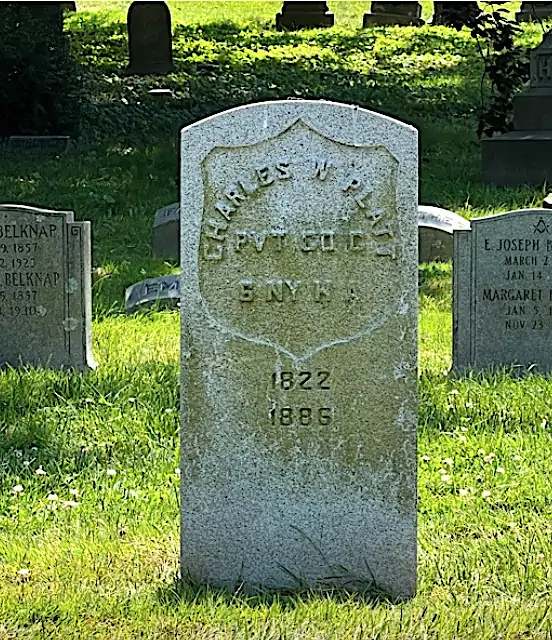

PLOEGER, THEODORE (1824-1904). First lieutenant, 5th Regiment, New York State Militia, Company A. A German native, Ploeger enlisted at New York City as a second lieutenant on April 19, 1861, and was commissioned into Company A of the 5th State Militia, also known as the Jefferson Guard, on May 5. When the Jefferson Guard was reactivated in 1863 and was part of the 5th National Guard, he was promoted to first lieutenant of his company on July 4 and mustered out on July 22, 1863, at New York City. He applied for an invalid pension in 1890, certificate 887,894. His last address was 430 St. Nicholas Avenue in Manhattan. Francissa Ploeger applied for and received a widow’s pension after his death from nephritis, certificate 577,282. Section 15, lot 17263, grave 2362.
PLUMB, MARTIN VAN BUREN (or V. B.) (1837-1919). Private, 13th Regiment, New York State National Guard, Company H. A Lackawaxen, Pennsylvania native, he enlisted at Brooklyn as a private on May 28, 1862, mustered into the 13th Regiment, and mustered out with his company on September 22, 1862. As per the census of 1870, Plumb was living in Brooklyn with his mother, wife and extended family; he was working as a cartman and had a personal estate worth $2,500. In 1903, his application for an invalid pension was approved, certificate 1,067,249. Plumb lived in Brooklyn throughout his adult life. Section 167, lot 18018.
PLUMMER, JOHN F. (1840-1906). Private, 13th Regiment, New York State Militia, Company G. Born in Boston, Massachusetts, Plummer was a member of the 13th Regiment and went to the front for three months in 1861. In civilian life, he was in the dry goods business. His obituary, published in the Brooklyn Standard Union, described him as an “old time Republican politician” and highlighted his illustrious public and private career: he was narrowly defeated by Theodore Roosevelt for leader of the old Twenty-first Assembly District in New York City in 1884, was a Republican candidate for controller in 1884, a delegate to Chicago in 1888, and organizer of the Downtown Association, which took an active part in the Harrison campaign.
Subsequently appointed by President Harrison as government director of the Union Pacific Railroad, Plummer was instrumental in establishing the town of Everett, Washington. In 1890, he sued the International Power Company for $1,000,000 for his services in raising $6,000,000 with which the American Locomotive Company was financed, a case in the hands of a referee at the time of his death. He became a member of the Chamber of Commerce in 1880 and was three times vice-president of the Union League Club. His last residence was 9 East 43rd Street, Manhattan. His death was attributed to myocarditis. Section 176, lot 20687.

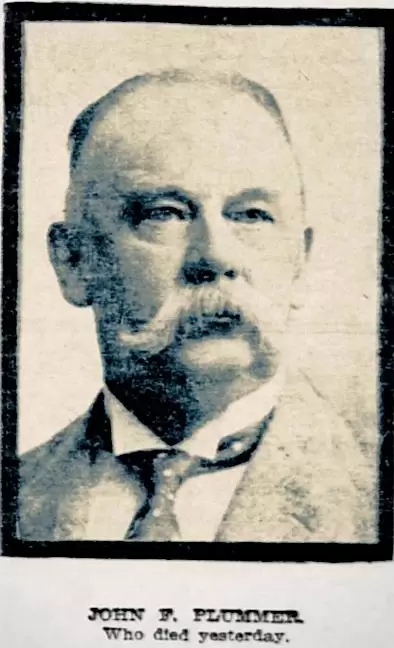
PLUMSTEAD, MANNING F. (1842-1867). Sergeant, 131st New York Infantry, Company H. Plumstead enlisted at New York City as a sergeant on August 18, 1862, and mustered into the 131st New York on September 6. His right leg was amputated after sustaining severe wounds at Port Hudson, Louisiana, on May 23, 1863, and was discharged because of his injury on March 30, 1864. He applied for and received an invalid pension on April 2, 1864, certificate 29,525. Plumstead’s one year old son, also named Manning, died on the same day as his father. He last lived in New Jersey where he died from typhoid fever. His mother, Margaret, applied for a survivor’s pension in 1867, certificate 139,814. Section ?, lot ?.

PLUNKETT, WILLIAM R. (1825-1863). First lieutenant, 159th New York Infantry, Company K; private, 13th Regiment, New York State Militia, Company C. On April 23, 1861, Plunkett enrolled as a private at Brooklyn, mustered into the 13th Regiment on May 17, and mustered out with his company on August 6, 1861, at Brooklyn. After re-enlisting as a second lieutenant at Brooklyn on September 18, 1862, he was commissioned into the 159th New York nine days later, and promoted to first lieutenant on November 3, 1862. He received a gunshot wound to the head, just above his eye at Irish Bend, Louisiana, on April 14, 1863, and succumbed to his wounds three days later at the hospital in Brashear City, Louisiana.
Colonel Henry W. Birge noted Plunkett’s death and that of another lieutenant in his field report from Opelousas, Louisiana, on April 22, 1863, “Their names are added to the list of patriots who have illustrated their devotion to their country by the sacrifice of their lives.” Lieutenant Herman Smith spoke of Plunkett in his report to the 159th Regiment’s headquarters from Camp Kearny in Carrollton, Louisiana, on August 18, 1863, praising his “soldierly conduct and valor in the face of the enemy.” Smith thanked the 159th for upholding the honor of New York and said, “The regiment now bears an enviable reputation for endurance and courage, and full confidence is felt that if called upon it will continue to win fresh honors.” As per the obituary of Gilbert Draper (see) in the New York Herald on December 18, 1863, both officers were killed in the same battle, arrived from New Orleans on the same day, and were buried at Green-Wood on the same day. The obituary noted that Plunkett’s body was escorted to the cemetery by members of Company I of the 36th National Guard.
His widow, Frances A. Plunkett, applied for and received a pension in 1863, and also a pension for their two young daughters, Annie and Fannie, certificate 25,641. Her pension was reduced and docked retroactively in 1864, due to the Pension Bureau disputing both Plunkett’s promotion and date of death. It was suspended in 1870 upon her remarriage to John Donlin, and a new certificate issued in 1871 for the children, certificate 155,062. In 1902, she applied for reinstatement of her pension under the law of March 3, 1891, at which time the Pension Bureau acknowledged Plunkett’s correct rank and date of death. A marble government-issued gravestone was ordered for him early in the 20th century. Section 115, lot 13536 (Soldiers’ Lot), grave 25.
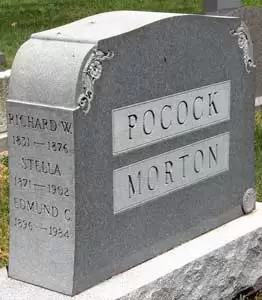
POCOCK, RICHARD W. (also enlisted as WATTS, RICHARD) (1831-1876). Commissary sergeant, 1st Connecticut Cavalry, Company E; sergeant, 51st New York Infantry, Company E. A native of England, he enlisted at New York City as a private on September 9, 1861, and immediately mustered into the 51st New York. He was promoted to sergeant on March 21, 1862, and deserted on November 28, 1862, at New York City. Re-enlisting under the name Richard Watts on December 6, 1862, he mustered that day into the 1st Connecticut Cavalry as a private, was promoted to corporal on March 1, 1863, and to commissary sergeant two months later on May 1. Taken as a prisoner of war at Old Church, Virginia, on June 10, 1864, he was paroled on April 9, 1865, and discharged on June 8, 1865. He last resided in Brooklyn at 453 Carlton Avenue. Pocock died of consumption. In 1890, Mary Pocock applied for and received a widow’s pension, certificate 708,790. Section 154, lot 22281.
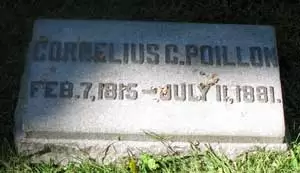
POILLON, CORNELIUS C. (1815-1881). Shipwright. Born in New York, he was senior member of C. & R. Poillon, shipwrights. He built the gunboat Winona and the steamers Newbern and Grand Gulf for the Union Navy during the Civil War. In addition, he built gunboats for the Brazilian and Spanish governments, as well as steamships for the Hartford and Troy lines and many yachts. He was also a member of New York City’s Volunteer Fire Department. He died of diarrhea at his residence, 7 East 32nd Street, Manhattan. Section 57, lot 8583.
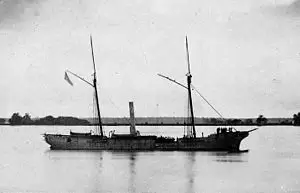

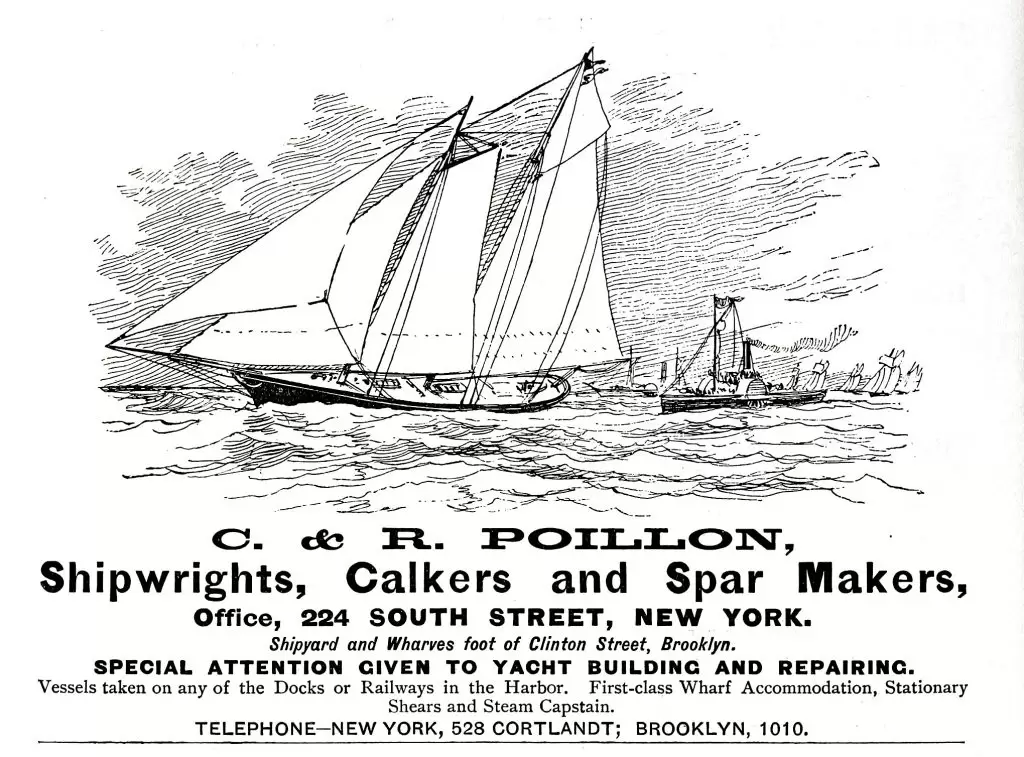

POKORNY, ANTHONY (or ANTON) (1823-1869). Lieutenant colonel, 7th New York Infantry; major, 8th New York Infantry, Company B. Born in Neuhaus, Bohemia, Pokorny came to the United States circa 1848, on the ship Kepler from Bremen. He enlisted at age 39 at New York City as a captain on April 23, 1861, was commissioned immediately into the 8th New York, and was promoted to major on November 12, 1861. In his field report of September 1, 1862, from Centreville, Virginia, Brigadier General Julius Stahel, United States Army, commended Pokorny for his distinguished bravery and gallantry at Groveton and Bull Run, Virginia.
After he mustered out on April 23, 1863, at Brooks’ Station, Virginia, Pokorny re-enlisted at New York City and was commissioned into the 7th New York as lieutenant colonel on November 2, 1864, and fought under Major General A. A. Humphreys in II Army Corps, 1st Division, 3rd Brigade. He commanded four companies of the 7th at the engagement at Deep Bottom, Virginia, on July 26-29, 1864, and five companies of the 7th at the Battle of Strawberry Plains, Virginia, from August 14-18, 1864. On January 16, 1865, while camped at a place near Hatchers Run, Virginia, he was the field commander for the day, and while going to check on his troops, had to cross a stream on horseback because the bridge had been knocked out by a recent storm. Both Pokorny and his horse fell through the ice and he was seriously injured in the stomach (ultimately, in 1869, this injury proved to be fatal). After being unable to serve for six weeks, he returned to his regiment which he led in the Appomattox Campaign from March 28-April 15, 1865. On April 7, neither side had rations because food was kept at the railroad depot there. He wrote the following in his battle report on April 15, after his troops captured 85 prisoners:
“…On the morning of April 2 we advanced toward South Side Railroad; march in line of battle, forty men of the regiment acting as flankers on our left. At 9 o’clock reach the enemy’s breast-works, when our flankers were employed as skirmishers in the front; found the breastworks abandoned. Advance about four miles, till near South Side Railroad, and attacked the enemy in his strong intrenchments (sic). The first charge was made almost exclusively by this brigade, but being vastly inferior in numbers we had to retreat with heavy loss. Some artillery came to our assistance. A second charge, in which the regiment took the lead, was likewise unsuccessful. At a third charge, assisted by Colonel Nugent’s brigade, we dislodged the enemy, and encamped near South Side Railroad for the night, after having given a guard of forty men to watch the prisoners. Our loss on this day consisted in 1 major and 4 line officers wounded, 14 men killed, 40 men wounded, 1 lieutenant and 27 men missing…”
After he mustered out on August 4, 1865, at Hart’s Island, New York Harbor, he served as an officer in the Freedman’s Bureau in Georgia for eight months in 1868, although he was in poor health. He applied for and received an invalid pension. The spelling of his name as “Pakorny” in Green-Wood’s records is incorrect. He last lived at 313 9th Street in New York City. Shortly after his death in 1869, Henriette Pokorny applied for and received a widow’s pension. Section 115, lot 4196, grave 397.
POLAK (or POLSK), KARL THEODORE (1842-1918). Unknown soldier history. Born in Alsace-Lorraine, (an area disputed by France and Germany), his obituary in the Brooklyn Standard Union indicates that he was born in France, but another document says Germany. As per his obituary, he immigrated to the United States when he was sixteen years old. Polak was identified as a Civil War veteran in his obituary in The New York Times but there are no details about his service.
In 1867, he became a naturalized citizen. According to the 1880 census, he was a dry goods commission merchant in Manhattan. A thirty-second degree Mason, he was a member of the Anglo-Saxon Lodge. Active in his church, he was a vestryman of the Holy Cross P. E. Church in Plainfield, New Jersey. He died of heart disease at his summer home in Spring Lake, New Jersey. His funeral took place at the Church of the Redeemer on Fourth Avenue and Pacific Streets in Brooklyn. Section 21, lot 36449.

POLHAMUS, JR., HENRY A. (1839-1883). Private, 7th Regiment, New York State Militia, Company H. Polhamus, who was born in New York City, enlisted in 1861 and served for 30 days with the 7th Regiment. When the 7th was reactivated in 1862, and was part of the New York State National Guard, he returned to the same company and served for three months.
The 1875-1876 New York City Directory lists Polhamus as a merchant at 140 Front Street with a home in New Rochelle, New York; the 1877 New York City Directory indicates that the 140 Front Street business was in oils. His last residence was in New Rochelle, New York. In his obituary, veterans from his company in the 7th Regiment were requested to attend his funeral and were given a train schedule from Grand Central Station. Section 80, lot 2954.


POLLOCK, ALEXANDER (1838-1904). Third assistant engineer, United States Navy. Pollock enlisted in the United States Navy on May 25, 1861, served as a third assistant engineer on the USS Montgomery, and was discharged on August 9, 1862. He was a member of the Grand Army of the Republic, George Washington Post #103 in New York City. His last address was in Glenridge, New Jersey. Annie Pollock applied for and received a widow’s pension in 1908. Section 158, lot 15037, grave 5.
POLLOCK, CHARLES (1820-1865). Sergeant, 68th New York Infantry, Company F. Born in Ireland, Pollock enlisted at New York City as a private on August 23, 1861, mustered into the 68th New York eight days later, was promoted to sergeant on November 30, 1862, and reduced to ranks at some point. He was discharged for disability on September 10, 1863, at Warrenton, Virginia. His last residence was 335 West 26th Street, New York City. Section 3, lot 8362.
POLLOCK, DAVID JOHNSTON (or JOHNSTONE) (1826-1868). Acting third assistant engineer, United States Navy. Pollock was born in Albany, New York. As per the New York State census of 1855, he lived in Manhattan as a boarder and worked as an engineer. On June 29, 1857, he married Martha Jane Adams at the Charles Street United Presbyterian Church in Manhattan. The 1860 census notes that he was married with an infant, still living in Manhattan and still employed as an engineer. During the Civil War, Pollock enlisted on September 12, 1861, served aboard the USS Augusta as an acting third assistant engineer, and resigned on September 9, 1862.
According to a descendant, Pollock was a merchant marine after his Naval duty and was the chief engineer on the steamship Gulf City (the former steamship Augusta Dinsmore), a vessel that transported goods between New York and Galveston, Texas. He died in an accident at Pier 20 on the East River in New York City on November 21, 1868, aboard that craft when he was caught in the machinery and crushed to death. The Gulf City, scheduled to depart for Galveston on that day, was delayed two days because of the accident. Pollock’s obituary in the New York Herald notes that he was the chief engineer of that vessel and died instantly. Further, the Herald reported that he was “a gentleman of exemplary habits and the head of a large family.” As per another obituary, his funeral took place at the First Baptist Church in Hoboken, New Jersey; his friends and family and those of his two brothers and his father-in-law, Henry Adams, were invited to attend. Cemetery records list his death as a “casualty.”
Sadly, the Gulf City ran aground off Point Lookout, North Carolina, on January 14, 1869, on its return home from Galveston; of the 25 men aboard, only three were saved as per an article in the Daily Alta California on February 4, 1869. In November 1891, Martha Jane Pollock, who is interred with him, applied for a Navy widow’s pension citing that she had not remarried since her husband’s death, owned no real estate and her personal property, valued at less than $100, was limited to household furniture. Further, she stated that since June 1890, her total income was about $300 and her only means of support was her daily labor. She was awarded a widow’s pension of $8.00 per month, certificate 7373. Originally interred in lot 4427, his remains were transferred to lot 12370 in 1883. Section 182, lot 12370.


POLSON, JOHN (1823-1868). First lieutenant, 3rd New York Light Artillery, Battery B. Originally from Ireland, Polson enlisted on April 29, 1861, at Elmira, New York, as a first lieutenant. On May 22, 1861, he was commissioned into Battery B of the 3rd New York Light Artillery serving there until he resigned on January 24, 1862. His last residence was 202 East 42nd Street in Manhattan. His death was caused by empyema, a lung condition. Section B, lot 8100, grave 611.
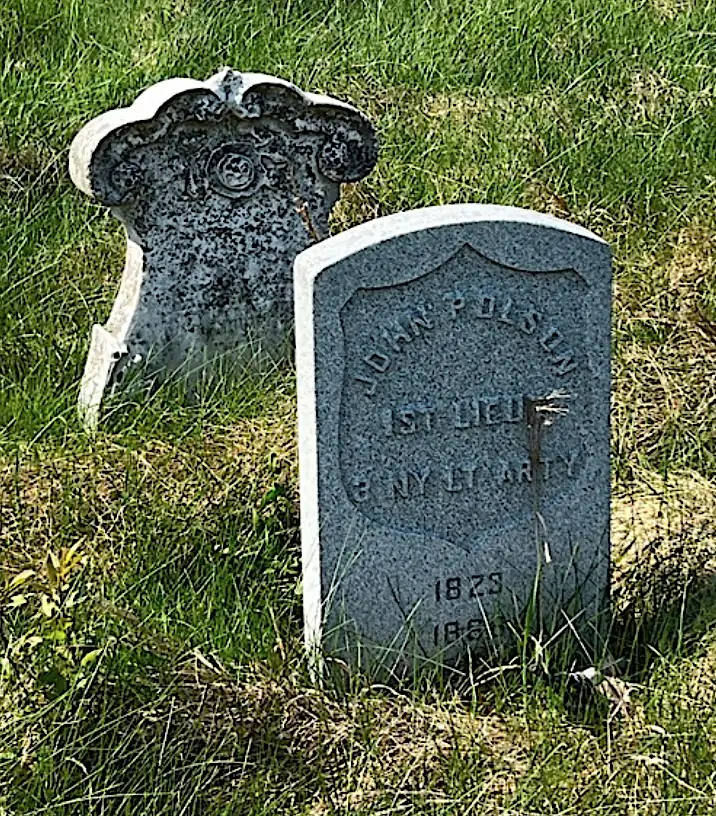

POLSTER (or POLESTER), HERMANN (or HERMAN) (1843-1883). Private, 88th New York Infantry, Companies B and A. A native of New York City, he enlisted there on September 12, 1861, and mustered into the 88th eight days later. He was transferred into Company A on June 12, 1863, re-enlisted on December 31 of that year, and deserted on February 13, 1864, at the expiration of his furlough. He died from phthisis in Brooklyn at a rest-home. Section 17, lot 17245, grave 415.
POMEROY, JOHN (1832-1886). Sergeant, 4th New York Infantry, Company F. Pomeroy, who was born in New York State, enlisted at New York City as a corporal on April 22, 1861. Ten days later, on May 2, he mustered into the 4th New York and was promoted to sergeant of his company on May 31. He was reduced in rank to private on March 8, 1862, and mustered out on May 25, 1863, at New York City. His last residence was 248 East 32nd Street in Manhattan. Pomeroy died from phthisis. Section 127, lot 17931, grave 182.
POOLEY, SAMUEL J. (1837-1862). Private, 1st New York Infantry, Company D. A native of New York who resided on Columbia Street in Manhattan, Pooley enlisted at New York City as a private on January 3, 1862, and immediately mustered into the 1st New York. He died of typhoid fever on July 15, 1862, at Fort Monroe, Virginia, and was interred at Green-Wood a month later on August 14. Section 44, lot 5028.

POPE, FRANK (or FRANCIS) ASBURY (1839-1880). First lieutenant, 29th Mississippi Infantry, Company A, Confederate States of America. A Mississippi native, Pope graduated from the University of Mississippi, class of 1861, where he was a member of the Delta Psi fraternity. He was 6′ 1″ tall with gray eyes, dark hair and complexion. On March 15, 1862, he enlisted as a second lieutenant at Lexington, Mississippi, (the county seat of Holmes County), and mustered into the 29th Mississippi. Pope was promoted to first lieutenant on May 17, 1862, and was slightly wounded on the left side during an engagement at Munfordville, Kentucky, on September 19 of that year. Listed as absent on the muster rolls for March and April 1863, he was on conscription duty at that time. He was captured at the Battle of Lookout Mountain at Chattanooga, Tennessee, on November 24, 1863, and was held as a prisoner of war at Johnson’s Island, Ohio, as of December 1, remaining there until he took the oath of allegiance to the United States on June 13, 1865, and was released.
According to the 1870 census, he was a lawyer living in Georgetown, Colorado. He represented “the people” there in a notorious murder case in which a miner killed his wife and tried to escape to Canada. At the time of his death from aortic stenosis, he was a lawyer living in New York City at the Gilsey House Hotel, a notable building at 1200 Broadway opened in 1871 that was the first to offer telephone service to guests. Gilsey House was a favorite of Southerners visiting New York. Section 146, lot 19438, grave 63.

POPE, JOHN (1823-1876). Private, 98th New York Infantry, Company K. Born in Ireland, Pope enlisted on December 1, 1861, at Canandaigua, New York, as a private, and mustered into his company six days later. He re-enlisted on January 2, 1864, but deserted on April 6, 1864, at Lyons, New York. He last lived in Bay Ridge, Brooklyn, where he died from pneumonia. Section 146, lot 22196.
PORTER, ATWOOD (1841-1906). Private, 83rd New York Infantry, Company A. Porter, who was born in New Rochelle, New York, enlisted at New York City as a private on May 27, 1861, and mustered into the 83rd New York on that date. He was discharged from military service on October 11, 1861, because of a disability. According to census data from 1880, he was employed as a bank note engraver. In 1905, he successfully applied for an invalid pension, certificate 1,112,820. Porter died from pneumonia in 1906. Martha Porter, who is interred with him, applied for a widow’s pension after his death, application 850,803, but she apparently died before it was certified. Section G, lot 21690.

PORTER, FITZ JOHN (1822-1901). Brigadier general by brevet; major general, United States Volunteers. He was born in Portsmouth, New Hampshire, the son of a captain in the Navy, nephew of Commodore David Porter and cousin of Admiral David Dixon Porter. After attending Philips Exeter Academy, he was appointed to the United States Military Academy, and graduated in 1845. He fought in the Mexican War, and was brevetted captain and major “for gallant and meritorious conduct” at Molino del Rey and Chapultepec in September 1847. He was an assistant instructor of artillery at West Point from 1849 until 1857, then served in the West as part of the Utah expedition.
When the Civil War began, Porter was appointed brigadier general of volunteers on May 17, 1861. On May 26, 1862, in his field report describing the actions at Hanover Courthouse, Virginia, he wrote that the following were accomplished:
The defeat and rout at Hanover of Brigadier-General Branch’s command, which comprised about 8,000 Georgia, North Carolina, and Virginia troops, with the loss to them of 8 officers and more than 1,000 men killed, wounded, and made prisoners, the capture of one gun and many stand of arms, and of camp equipage, officers’ baggage, &c., and of army stores to a much greater amount than we could bring away, in addition to a still larger quantity destroyed by the enemy in his flight; the destruction of extensive bridges on the Virginia Central and the Richmond and Fredericksburg Railroads, and on the main wagon roads leading north from Richmond (including the destruction of telegraphic communication on those roads), thus cutting off the rebel force in Northeastern Virginia from all rapid relief from that city and from the avenues available for retiring on it, except via Lynchburg. This also excludes Richmond from two of its four remaining avenues of supply; the destruction of all bridges over the Pamunkey and the roads on our right, thus securing us from any attack on our right and rear.
After indicating that an attack on Washington was unlikely, he went on to praise the troops:

The regiments behaved most gallantly. Some, as occasion required, were heroic in their brave and successful resistance to the shock of vastly-superior numbers, holding their ground against all odds till relief arrived. Maine, Massachusetts, Connecticut, Rhode Island, New York, Pennsylvania, and Michigan were all represented, no State or section taking any exclusive part in any labor or danger, and the sons of each fought as becomes national soldiers, and bore with cheerfulness the long marches through heavy rain and mud and the exposures and privations incident to a forced march without shelter or supply trains…
His heroic actions and leadership were cited by Major General George McClellan in his field report and in a letter to Secretary of War E. M. Stanton written on May 30, “It was one of the handsomest things in the war, both in itself and in its results. Porter has returned, and my army is again well in hand. Another day will make the probable field of battle passable for artillery. It is quite certain that there is nothing in front of McDowell at Fredericksburg. I regard the burning of South Anna bridges as the least important result of Porter’s movement.” In his history of the Civil War, William Swinton commended Porter’s ability to send in his forces to quickly use axes and spades to build defensive positions at Gaines’ Mills, Virginia. He was brevetted brigadier general on June 27, 1862, for “gallant and meritorious conduct in the Battle of Chickahominy, Virginia,” and made major general on July 4, 1862. During the War, Porter ascended in an observation balloon that was supposed to be tethered 100 feet in the air. However, the rope broke, and Porter could not bring the balloon down until it had carried him several miles behind Confederate positions; he was eventually rescued. A loyal supporter of General George McClellan, he fought with distinction in command of the Fifth Corps during the 1862 Peninsula Campaign. His troops were heavily attacked at Mechanicsville and Gaines’ Mill; he rallied them and was able to withdraw. His skillful efforts to cover the Army’s retreat at Malvern Hill, Virginia, resulted in his promotion to major general.
He, like many of the officers who had served under McClellan, despised General John Pope; Porter openly said so. As John Hay, assistant private secretary to President Lincoln, said of him, “Porter was the most magnificent soldier in the Army of the Potomac, ruined by his devotion to McClellan.” After Second Bull Run, Virginia, Pope charged Porter with disloyalty, disobedience, and misconduct in the face of the enemy. Porter was relieved of his command, and found guilty at a controversial court-martial presided over by anti-McClellan officers. At his court-martial, he presented evidence in his defense and concluded with the following statement:
…Without assuming to myself a purer patriotism than animates the soldiers of the Union, I say fearlessly that none, no, not one, loves our Union with a stronger, a holier love. There is nothing in the future, as there has been nothing in the past, that I would not do and gladly do to achieve its victory over its enemies and to bind up the wounds under which it now bleeds. Life! what is it to the soldier who is false to his flag and his country? Life! what will be its value to the soldier (may God avert the calamity!) who may survive to witness its flag trailed in the dust, its reputation and power broken, its people separated into fragments, their fraternal affection converted into bitter sectional hate, and the cause of constitutional freedom itself for ages, if not forever, extinguished. As far as one arm and the aspirations of one heart may be exerted to avert the dire calamity, mine will be used to the last moment of my life. I live now amidst whatever discouragements surround us, and through the gloom which they cause, cheered only by the anticipation that all will yet be well; that our Union will emerge from its present dangers even stronger for the trials through which it is passing; that it will be ours once more to be proud of and to glory in and again serve to light the world by the effulgence of its example; that it will become, as it was but recently, a monument of past renown and a pledge of future glory, and will so continue “till time’s last echo shall have ceased to sound.
Porter was cashiered from the Army on January 21, 1863, spent the ensuing years trying to clear his name, and was finally exonerated in 1878. A Presidential order on May 4, 1882, said the following, “…And whereas doubts have since arisen concerning the guilt of the said Fitz John Porter of the offenses whereof he was convicted by the said court-martial, founded upon the result of an investigation ordered on the twelfth day of April, 1878, by the President of the United States, which are deemed by him to be of sufficient gravity to warrant the remission of that part of said sentence which has not yet been completely executed: Now, therefore, know ye that I, Chester A. Arthur, President of the United States, by virtue of the power vested in me by the Constitution of the United States and in consideration of the premises, do hereby grant to the said Fitz John Porter full remission of the herein before mentioned continuing penalty.”
Again, however, politics intruded, and it was not until 1886 that he was finally restored to the rank of colonel, without back pay. Most historians have concluded that Porter was a talented officer whose offense was indiscretion. He was superintendent of mining operations for New York companies in the Colorado Territory from 1864‑65, then was a merchant in New York City from 1865‑71. Subsequently, he was superintendent in the construction of the New Jersey State Asylum for the Insane at Morristown, 1872‑75. He returned to New York City where he was Commissioner of Public Works from March 1, 1875, to January 18, 1876. A public servant, he was assistant receiver of the Central Railroad of New Jersey, 1877‑82, then Police Commissioner of New York City, 1884‑88, and New York City Fire Commissioner, 1888‑89. At some point after the Civil War, he declined an offer from the Khedive to command the Egyptian army. He last lived on Farragut Place in Morristown, New Jersey. His death was caused by chronic diabetes. Section 54, lot 5686.





PORTER, JAMES H. (1844-1928). Private, 12th Regiment, New York State National Guard, Company H. Some data reflects information as indicated by his gravestone. Porter, who was born in New York, served for three months in 1862 as a private in 12th Regiment. He last lived at 12 West 103rd Street in Manhattan. Porter died of carditis. Section 69, lot 3580.
PORTER, WILLIAM DAVID (1808-1864). Commodore, United States Navy. A native of New Orleans, Louisiana, he was born into a family of Naval officers. His father was Commodore David Porter, his brother, Admiral David Dixon Porter, and his foster brother was the renowned Admiral David Farragut. His family moved to Chester, Pennsylvania, where he spent his childhood before signing on to his uncle’s ship, the Franklin, at age 12. Appointed mid-shipman on January 1, 1823, he rose to lieutenant in 1834. A lighthouse inspector from 1838-1840, he was assigned to the east coast from New York City to Norfolk, Virginia, and then served as ordinance officer at the Washington Navy Yard where he became interested in the development of an explosive shell for naval use. In the 1840s, he was engaged in outfitting steam ships, commanding supply vessels and delivering mail and supplies overseas. Porter retired in 1855 but returned to service in 1859 and commanded a sloop, the St. Mary, which patrolled the waters off Mexico and Central America.
At the onset of the Civil War, the St. Mary returned to her base at Mare Island, California, and Porter was relieved of command in the summer of 1861 and assigned to Washington, D.C. He then was sent to St. Louis, Missouri, in the fall where he assisted in the establishment of a western flotilla, a project designed to seize and control the Mississippi and its tributaries for the Union. As of October 3, 1861, serving under Captain Andrew Foote, who commanded the Mississippi River Squadron, he patrolled the Cumberland River aboard the gunboat New Era, and kept an eye on growing Confederate defenses on that river. In November, that vessel was repaired in St. Louis and when returned to service, the gunboat was renamed the Essex, in honor of a frigate of the same name that Porter’s father commanded during the War of 1812.
On January 10, 1862, the Essex and another Union gunboat, the St. Louis, engaged three Confederate gunboats and forced them to retreat to Southern shore batteries. The action was repeated three days later and the Confederate gunboats were damaged but not captured. While in command of the Essex at Fort Henry, Tennessee, on February 6, 1862, the ship suffered damage when its bow was rammed and the boilers exploded releasing steam that scalded 26 men including Porter, who although severely injured and temporarily blinded, led his ship away in retreat. From his hospital bed, he directed the construction of two ironclads, the Lafayette and the Choctaw.
After directing the repair of that vessel and the construction of other ironclads, Porter returned to Vicksburg, Mississippi, that July and was engaged in an action with the CSS Arkansas in which the Essex suffered some damage after running aground.
Because the Essex sustained only minor damage, Porter continued to command it as it patrolled the lower Mississippi between Vicksburg and Baton Rouge, disrupting commerce in an area still controlled by the Confederacy. Initially, on August 5, 1862, the Essex and the Sumter assisted Union troops in repelling an attack on Baton Rouge. The next morning, the Essex once again engaged the CSS Arkansas between Vicksburg and Baton Rouge, Louisiana, in which Porter used an incendiary device of his design that may have led to the Arkansas erupting in flames. (By some accounts, the Confederate crew blew the ship up to prevent her capture.) In June 1864, Congress awarded the crew prize money of $25,000 for their role in that endeavor.
In September 1862, Porter was aboard the Essex in Natchez, Mississippi. There, the Essex bombarded that city and dueled with shore batteries at Port Hudson, Louisiana. Later that month, he was promoted to commodore and sent to New York where he died of heart disease at St. Luke’s Hospital on May 1, 1864. Originally buried at Green-Wood, his remains were moved to Philadelphia, Pennsylvania, in June of that year where he is buried alongside his father, Commodore David Porter, at the Woodlands Cemetery.
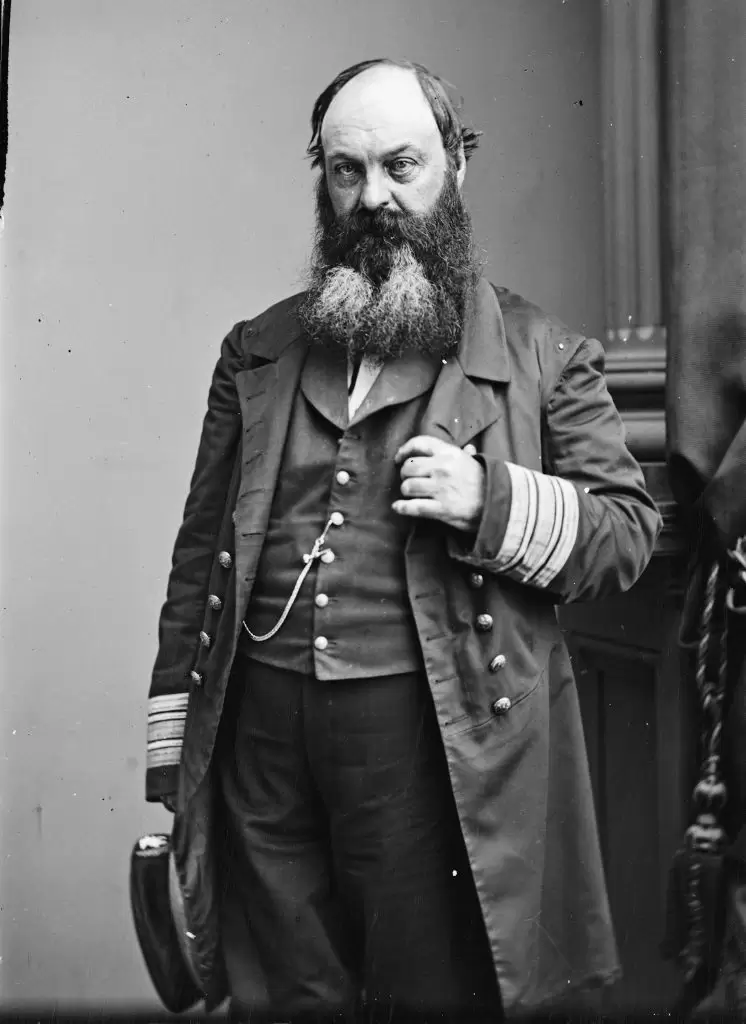

PORTINGTON, ROBERT C. (1831-1879). Private, 7th Regiment, New York State Militia, Company C. Originally from Boston, Massachusetts, Portington first joined the 7th Regiment in 1858. He was a member of the honor guard that took part in the ceremonies removing the remains of President James Madison from a New York City cemetery. At the onset of the Civil War, he enlisted and was a private in Company C of the 7th Regiment for 30 days mustering out at the end of his term. He is listed as being in the furniture business in the Brooklyn Directory for 1873-1876 and the New York City Directory for 1876-1878. His last residence was 84 Gates Avenue in Brooklyn. Section 44, lot 2334.
POST, JR., ALANSON W. (1844-1866). Private, 50th New York Engineers, Company C. A Brooklyn native, Post enlisted as a private at Verona, New York, on January 4, 1864, mustered immediately into the 50th New York Engineers, and was discharged for disability on August 3, 1864, at Washington, D.C. He died from typhoid fever at his home at 270 South 3rd Street in Brooklyn. Section 95, lot 966.
POSTLEY (or POSTLY), DE VAN (1842-1863). Second lieutenant, 174th New York, Company D; private, 7th Regiment, New York State Militia, Company B. Postley was born in New York City and enrolled there on April 17, 1861, to serve for 30 days in the 7th Regiment under the command of Colonel Marshall Lefferts (see). He mustered in on April 26, and accidentally shot himself with his own pistol during the march to Washington, D.C. His company mustered out on June 3 at New York City. Returning to the same regiment and company for three months in 1862, now part of the New York State National Guard, he enrolled on April 25 at New York City, mustered in as a private on June 19, and mustered out with his company at New York City on September 5. A month later, he re-enlisted at New York City as a second lieutenant on October 20, and was immediately commissioned into the 174th New York. The 174th, nicknamed the 5th Metropolitan Guard, saw action in the Gulf region, first at Port Hudson, Louisiana. Postley was killed in combat on July 13, 1863, when his flank retreated without cover at Donaldsonville, Louisiana, during the Battle of Cox’s Plantation, a humiliating defeat for the Union which outnumbered their opponents by more than three to one. Postley was the only officer of the 174th killed in that engagement. He was interred at Green-Wood on March 7, 1864; his funeral attended by members of his company from the 7th Regiment. He was the nephew of Washington Postley (see). Section 60, lot 2588.


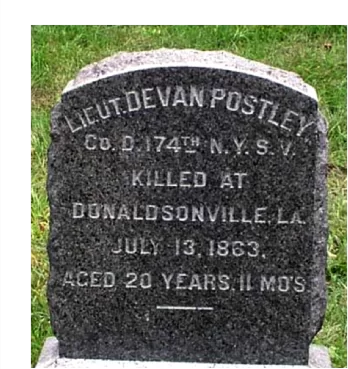
POSTLEY, WASHINGTON M. (1824-1910). First lieutenant and adjutant, 78th New York Infantry. A New York City native, the 1850 census reports that Postley lived there with his wife and two young children; he then worked as a dentist. Postley enlisted as an adjutant at New York City on October 1, 1861, and mustered immediately into the Field and Staff of the 78th Infantry; he was a widower at the time of his enlistment. As per his muster roll, he was a contractor who was 5′ 10″ tall with gray eyes, black hair and a dark complexion. The 78th New York was assigned to Pope’s Army of Virginia’s 2nd Corps and saw action at the Battles of Cedar Mountain and 2nd Bull Run. During those engagements, Postley was listed as sick at Washington. His online biography at Find A Grave notes that he was then absent without leave but never charged. He mustered out on April 1, 1862, at New York City.
Postley re-enlisted as a first lieutenant and adjutant on May 17, 1862, and was commissioned into the Field and Staff on July 17, 1862, with rank from the date that he mustered in. In September 1862, the 78th was assigned to the Army of the Potomac and served at Antietam, Maryland, at Fredericksburg and Chancellorsville in Virginia, and at Gettysburg, Pennsylvania. As per his Find A Grave biography, he missed Antietam but returned to the rolls present but under arrest in December 1862. Apparently, he was court-martialed for being AWOL but the records were lost and he returned to duty. His commanding officer praised him for his actions at Gettysburg citing “the coolness and zeal with which he kept the regiment supplied with ammunition under a very hot fire.” Postley was honorably discharged on July 18, 1863, upon tendering his resignation, citing family concerns, as per Special Order 149.
A widower, Postley married Alice Castle on December 12, 1864. The 1870 census reports that Postley lived in Manhattan. Apparently, he deserted his wife and their two young children after about six years together. For a few months after his desertion, he called occasionally to see his children but then never came again. According to the 1886 New York City Directory, he was a lawyer. The Veterans Census of 1890 confirms his service in the Civil War and indicates that he lived in New York City. In 1903, his application for a pension was approved, certificate 1,066,804. He is buried with his nephew, De Van Postley (see). He last lived on West 22nd Street in Manhattan.
In 1910, Alice Postley applied for and received a widow’s pension, certificate 711,428. She asked for the $20 a month pension noting that her husband had a violent temper and never supported her. Section 60, lot 2588.


POTTER, JAMES DECATUR (1828-1888). Lieutenant colonel, 38th New York Infantry. He served as a second lieutenant in the First Regiment of New York Volunteers during the Mexican War and was wounded on April 18, 1847, at the Battle of Cerro Gordo. After enlisting on May 25, 1861, he was commissioned as major of the 38th New York on June 8. Wounded in the leg and taken prisoner at the Battle of First Bull Run, Virginia, on July 21, 1861, he was brought to Richmond, where he was imprisoned for more than a year. On July 29, 1861, the commanding officer of the 38th New York, Lieutenant Colonel Addison Farnsworth, wrote in his field report from Camp Scott, Virginia, how his officers led by “soldierly example,” noting, “Major James D. Potter was disabled during the early part of the engagement while gallantly performing his duty, and subsequently fell into the hands of the enemy.…”
During the bombardment of Charleston, South Carolina, Potter was brought to the fortifications there, where he was one of the Union prisoners selected by Confederate authorities to be hanged if Southern prisoners being held at Fort Lafayette in New York Harbor were executed. On February 26, 1862, J. T. Morrill wrote to Secretary of War E. M. Stanton describing the conditions of prisoners confined to Charleston. Potter, who was condemned, had no use of the yard to exercise, and had the following rations, “Our fare consisted of one-half pound of meat (bone included) and three biscuits daily; two ounces of coffee for five days and other small stores in proportion; the fuel was altogether insufficient to cook our provisions, being one small stick of yellow pine for two days for the whole mess.” He was later sent to Columbia, South Carolina, where conditions were better than expected and prisoners were treated humanely. Exchanged on September 30, 1862, he was promoted to lieutenant colonel on October 10, 1862, and was discharged on January 26, 1863.
Potter worked in the real estate business in New York City after the Civil War and was arrested in 1874 for the forgery of railroad bonds, spending several weeks in the Tombs before making bail. His last residence was 50 Varick Street in New York City. He succumbed to liver cancer. On October 28, 1888, 150 veterans, members of the Noah L. Farnham G.A.R. Post #458 led by a drum corps of 25 men, accompanied his remains to graveside. A government-issued stone marks his burial site. Section 115, lot 13536 (Soldiers’ Lot), grave 26.


POTTER, ROBERT BROWN (1829-1887). Major general by brevet; major general, United States Volunteers, Division 2, 9th Corps; colonel, 51st New York Infantry. Initially interred at Green-Wood, his remains were removed on November 3, 1894. Born in Schenectady, New York, his father was an Episcopal bishop and his grandfather was the president of Union College. Potter attended that institution but left to pursue a career in law. His first commission was in the 51st New York, known informally as “Shepard’s Rifles.” He was promoted to major of that regiment on October 14, 1861, and rose to lieutenant colonel on November 1, 1861. Brigadier General Jesse L. Reno, United States Army, in his field report from New Berne, North Carolina, on March 16, 1862, wrote that Potter, “…was wounded early in the action, but he most gallantly continued with the regiment during the entire battle and rendered very important service…” Edward Ferrero (see), the colonel of the 51st New York, singled him out in his report the next day for his “great gallantry and coolness.”

After becoming colonel on September 10, 1862, Potter was again deemed worthy of the “highest praise” by Ferrero, who was now brigadier general of the Army, for his actions in Fredericksburg, Virginia, on December 16, 1862. Among the other battles in which he fought were Cedar Mountain, Second Bull Run, and Chantilly (all in Virginia), and Antietam, Maryland, where he took part in the assault on the stone bridge. Potter’s “steadiness and courage” were considered noble as was the conduct of the 51st New York. After he became brigadier general on March 13, 1863, Potter commanded the 9th Corps of Division 2 from June 6, 1863-August 25, 1863, leading the Army and Department of the Ohio. Continuing his command of the 9th Corps, he was in charge of the Department of Tennessee from June 14, 1863-August 18, 1863, and then returned to lead the Army and Department of the Ohio from August 25, 1863-January 17, 1864. He then assumed command of the Army of the Potomac from May 1, 1864-April 2, 1865. After he was injured at the Battle of Petersburg, Virginia, on April 2, 1865, he continued to suffer from these wounds throughout his life. Brevetted to major general on August 1, 1865, he was commissioned to that rank on September 29, 1865, and mustered out in January 1866.
For the three years after the Civil War, Potter was receiver of the Atlantic & Great Western Railroad. He died from paralysis at his estate in Newport, Rhode Island. One of his sons, Eliphalet, was President of Hobart College.



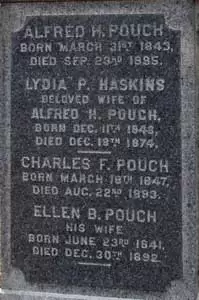
POUCH, ALFRED H. (1843-1895). Private, 84th New York (14th Brooklyn) Infantry, Company D. A native Brooklynite, Pouch enlisted there as a private on May 18, 1861, and mustered into the 14th Brooklyn five days later. On January 10, 1862, he deserted at Camp Marion in Upton Hill, Virginia. His last residence was at 21 Jamaica Avenue in Brooklyn. Section 187, lot 18525, grave 7.
POVIE, BENJAMIN C. (1839-1876). Private, 13th Regiment, New York State Militia, Company D. After Povie, a New York native, enlisted at Brooklyn as a private in 1861, he mustered into the 13th Regiment and mustered out after three months. His marriage on June 11, 1864, was posted in the newspaper. He is listed as an engraver in the Brooklyn Directories for 1868, 1867-1870 and 1873-1876. According to the 1870 census, he was an engraver living in Brooklyn whose real estate was valued at $5,000 and personal property at $600. His last residence was 66 North Oxford Street in Brooklyn. Section 15, lot 17263, grave 2088.
POWELL, BENJAMIN F. (1830-1889). Artificer, 15th New York Engineers, Company B; private, 67th New York Infantry, Company F. After Powell enlisted at Brooklyn as a private on May 20, 1861, he mustered into the 67th New York on June 20, and deserted from his unit on June 28, 1861, at Brothers Island, New York. However, the next day on June 29, 1861, he enlisted as a private at Willets Point, New York, and joined Company B of the 15th New York Engineers but was dropped from the rolls on December 31. Subsequently, he re-enlisted as a private at New York City on August 23, 1862, and mustered immediately into Company B of the 15th Engineers. He was promoted to artificer in June 18, 1863, and was discharged on July 2, 1865, at Washington, D.C. His last residence was 548 Seventh Avenue in Brooklyn. His death was attributed to degeneration of the heart. In 1892, Mary Powell applied for and was granted a widow’s pension, certificate 361,958. Section 2, lot 5499, grave 1043.
POWELL, CHARLES E. (1846-1922). Private, 37th New Jersey Infantry, Company A. A native of Troy, New York, Powell enlisted as a private on May 31, 1864, mustered into the 37th New Jersey on June 23, and mustered out on October 1, 1864, at Trenton, New Jersey. In the 1879 Jersey City Directory, he is listed in the shoe business. In 1898, he applied for and received an invalid pension under certificate 985,265. The 1910 census indicates that he worked as a self-employed real estate agent. He last lived at 547 Avenue E in Bayonne, New Jersey. Shortly after his death from cerebral arteriosclerosis in 1922, Frances Powell’s application for a widow’s pension was approved, certificate 933,828. Section 156, lot 20550, grave 3.
POWELL, HANS (1843-1885). Surgeon, 3rd New York Infantry; assistant surgeon 142nd New York Infantry. A native of Dublin, Ireland, Powell received his diploma there from the College of Surgeons in 1860. That same year, he immigrated to the United States and started his medical practice in New York City. During the Civil War, he enlisted as an assistant surgeon on March 30, 1862, and joined the Field and Staff of the 142nd New York. On April 8, 1863, he was formally commissioned into the 142nd, and transferred into the Field and Staff of the 3rd New York on June 8, 1865, where he was promoted to surgeon. He mustered out on August 28, 1865, at Raleigh, North Carolina.
Active in many G.A.R. organizations, Powell was a charter member, first commander and longtime medical officer of the local Dahlgren Post #113, and held the position of medical director for the New York State branch and surgeon-general for the national branch of the association. In 1874-1875, he served as police surgeon for the 7th Precinct of the New York City Police Department and continued his private practice throughout his life. Powell is listed as a physician in the New York City Directories for 1875, 1876-1878 and 1882-1883; his office was at 184 East Broadway in Manhattan. He applied for an invalid pension in 1884, application 526,208, but apparently died of endocarditis before it was certified. Powell last lived at 261 West 38th Street in Manhattan. His mother, Mary A. Powell, successfully applied for a pension, certificate 335,031. Section 192, lot 24310.


POWELL, WICKHAM (or WICKEN) C. (1843-1876). Private, 159th New York Infantry, Company H; drummer, 23rd Regiment, New York State National Guard, Company F. A New Yorker by birth and the son of a harness-maker, Powell first served for 30 days as a drummer in the 23rd National Guard in 1863. He re-enlisted as a private at the 2nd Congressional District of New York on November 11, 1863, and mustered into the 159th New York on November 23. He was taken prisoner of war at the Battle of Cedar Creek, Virginia, and paroled back to Union forces on October 19, 1864. He was discharged from service on August 4, 1865, at Savannah, Georgia.
According to the 1870 census, Powell was a store clerk. Although he applied for an invalid pension in 1873, application 182,002, there is no certificate number. Powell last lived at 999 Fifth Avenue in Brooklyn. He died in the fire at the Brooklyn Theater on December 5, 1876, a catastrophic event that claimed at least 278 lives and is memorialized by an obelisk at Green-Wood where 103 unidentified bodies were interred in a common grave. His tombstone is inscribed with his service in the 159th New York. Section 203, lot 25589.
PRAMBERG, EDWARD (1831-1901). Private, 132nd New York Infantry, Company E. Of Swedish origin, Pramberg enlisted at New York City as a private on September 8, 1862, mustered into his company six days later, and mustered out on June 29, 1865, at Salisbury, North Carolina. During his service, he was listed as absent due to sickness at New York City on an unstated date and was absent when his company mustered out. Although he last resided at 22 Goerck Street in Manhattan, he died of pulmonary tuberculosis at the Soldiers’ Home in Togus, Maine. Section A, lot 8100, grave 839.

PRATT, JOHN F. (1820-1892). Sergeant, 1st New York Infantry, Companies H and D; 39th New York Infantry, Company E; 2nd New York Battalion, 55th Company. A printer by trade, Pratt enlisted as a private on May 7, 1861, and was assigned to Company H of the 1st New York. The next day, he was transferred to Company D and assigned as an acting sergeant with the Quartermaster’s Department. After a promotion to sergeant on March 1, 1862, he remained with the regiment until he mustered out on May 25, 1863.
Pratt re-enlisted at New York City as a private on November 25, 1863, immediately mustered into the 39th New York, and was promoted to sergeant a month later on December 8. Following a gunshot wound to his right arm, between his elbow and shoulder, at Landron House, Virginia, on May 18, 1864, he was treated on the field and at hospitals in Fredericksburg, Washington, D.C., and Philadelphia, Pennsylvania. Pratt was transferred to the 55th Company of the 2nd Battalion on June 21, 1864. That company was known as the “invalid corps” and because his injury resulted in partial paralysis of his right hand, he was reduced in rank to private. He was discharged on July 20, 1865.
After the Civil War, Pratt was secretary of the 1st New York’s Association. In 1879, he applied for and received a pension but his physical problems prevented him from returning to the printing trade and he earned a living as a porter and as a circular distributor. His death was caused by phthisis (tuberculosis). In 1893, his widow, Dorothy Pratt, who is interred with him, applied for and received a pension. Section 127, lot 3139, grave 149.
PRATT, JOHN M. (1842-1929). Adjutant, 23rd Regiment, New York State National Guard. Of Irish birth, he enlisted on June 18, 1863, at Brooklyn, was commissioned into the Field and Staff of the 23rd New York that day, and mustered out at Brooklyn after 30 days on July 22. He last lived at the Soldiers’ Home in Kearny, New Jersey. His death was attributed to paralysis caused by a cerebral hemorrhage. Section 136, lot 28307, grave 13.


PRATT, JOSEPH H. (1840-1902). First lieutenant, 100th New York Infantry, Companies C and B; 84th U.S. Colored Troops, Companies E and F; second lieutenant, 4th New York Infantry, Companies A, B, E, and I. Born in Tremont, New York City, he enlisted as a private on April 22, 1861, and mustered into the 4th New York. At the expiration of his enlistment on May 25, 1863, he was a second lieutenant. His pension record indicates that he was also in Companies B, E, and I of that regiment.
Pratt then served in the 84th United States Colored Infantry (USCT) as a first lieutenant in Companies E and F. After re-enlisting in the 100th New York as a private at Kingston, New York, on October 12, 1864, he immediately mustered into Company C. A series of promotions followed: first sergeant on December 1, 1864; second lieutenant on April 18, 1865; and first lieutenant on July 20, 1865, effective upon his transfer to Company B. He mustered out at Richmond, Virginia, on August 28, 1865. Pratt was an original member of the Lafayette Post #140 of the G.A.R. His widow was granted a pension in 1902, certificate 671,288. His name is displayed on the African American Civil War Memorial in Washington, D.C., plaque C-90. Section 154, lot 25413.
PRATT, WILLIAM HALL BRACE (1842-1916), Private, 73rd New York Infantry, Companies I and B. Born in Brooklyn, Pratt enlisted and mustered into Company I of the 73rd New York on August 2, 1861. A month later, on September 1, he transferred into Company B. Pratt deserted at Fredericksburg, Virginia, on December 13, 1862. In civilian life, he was a physician. He last resided on Sixth Avenue in Brooklyn, His death was caused by arteriosclerosis. Section 145, lot 32623.

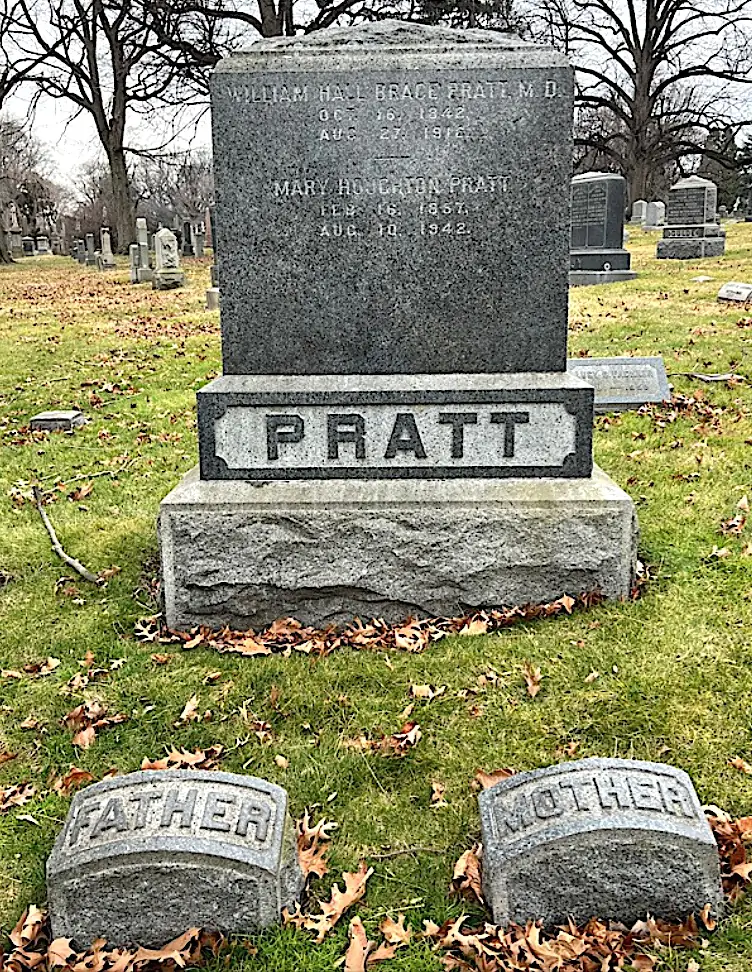
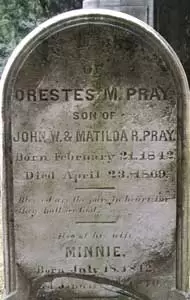
PRAY, ORESTES M. (1842-1869). Assistant surgeon, 31st New York Infantry; 13th Regiment, New York State National Guard. After serving in the 165th New York, he was promoted to assistant surgeon on February 10, 1863, enlisted six days later at Washington, D.C., mustered into the 31st New York’s Field and Staff that day, and mustered out on June 4, 1863, at New York City. Pray re-enlisted and was commissioned into the 13th Regiment on June 20 of that year, and mustered out the next month on July 21 at Brooklyn. He died on Long Island. Section 26, Lot 4153.

PRENTICE, FOWLER (1839-1867). Surgeon, 73rd New York Infantry; assistant surgeon, 30th New York Infantry. A native of Brooklyn, Prentice enlisted as an assistant surgeon on January 16, 1862, at Albany, New York, and was commissioned into the Field and Staff of the 30th New York on that day. On March 30, 1862, he was discharged for promotion to surgeon and commissioned into the Field and Staff of the 73rd New York. Wounded on or about August 15, 1864, at Petersburg, Virginia, he mustered out on May 17, 1865, at Washington, D.C. He last resided at 1 Grace Court in Brooklyn. Section 104, lot 170.

PRENTISS, CLIFTON KENNEDY (1835-1865). Colonel and lieutenant colonel by brevet; major, 6th Maryland Infantry, Company F (Union); private, 7th Regiment, New York State Militia, Company K, private, 5th Maryland Infantry (Union). Only two days after President Lincoln’s first call for troops, Prentiss, single and living near Baltimore, answered the call, enlisting as a private in the 7th New York State Militia, Company K, and serving until the 7th mustered out on June 3, 1861. On March 30, 1862, he enlisted as a private in the Fifth Regiment, Maryland Volunteers, and on July 31, 1862, he transferred to Company F of the 6th Maryland Infantry as a second lieutenant. As the Civil War dragged on, Clifton rose in the ranks, promoted to captain (Chief of Pioneers) on August 27, 1862, and major on December 2, 1862. He served in Virginia at the Battles of Winchester, Opequan Creek, Locust Grove, the Wilderness, Cold Harbor, Fort Steadman and Petersburg, as well as at Monocacy, Maryland. He also served in the Shenandoah Valley with great distinction at Fisher’s Hill and Cedar Creek. In 1864, soon after the Wilderness, he was assigned as chief of engineers under General James B. Ricketts, and served in that capacity at Spotsylvania and Cold Harbor.
Prentiss commanded the 6th Maryland at Opequan, Cedar Creek, and Petersburg. According to the report of the field correspondent for the New York Herald, during the Union advance on the Petersburg earthworks on April 2, 1865, Prentiss was the first officer to enter the enemy works. This claim is supported by General J. Warren Keifer, the brigade commander who, in his official report on April 14, stated: “Maj. Prentiss with a large portion of the 6th Md., was the first to penetrate the enemy works. After a most bloody struggle he fell mortally wounded very soon after entering the fortification. Too much praise cannot be given to the officers and men of this regiment.” John R. King, who wrote Sixth Corps at Petersburg- Its Splendid Assault, Which Broke the Main Line of the Rebels, in the April 15, 1920 National Tribune, gave this account, “A Pathetic Incident”: “Maj. Clifton K. Prentiss, a Baltimorean, was a man of exceptional bravery, a veritable cavalier. On this fateful morning he fell mortally wounded, as with waving sword he urged forward his men, to be the first to mount, with assistance, the enemy’s works.” Records indicate that he had suffered a gunshot wound to his left lung. Lieutenant Colonel Joseph Hill of the 6th Maryland singled out Prentiss for bravery in his field report of April 16, 1865, and concluded, “The Sixth Regiment Maryland Volunteers on that occasion acquitted herself with honor to her command, honor to her State and to her country at large…”
Both Clifton and William Prentiss (see) were taken to a Union field hospital near Petersburg. While William was held there, as a prisoner of war, his right leg was amputated. On May 14, both brothers were transferred to Armory Square Hospital in Washington, D.C. There, a nurse by the name of Walt Whitman, destined to become America’s greatest poet, ministered to them. Whitman estimated that he helped 100,000 sick or wounded soldiers in army hospitals during the three years of the Civil War that he served as a volunteer nurse. He wrote about approximately fifty of them. One such entry, for May 28-29, 1865, titled Two Brothers, One South, One North, told about his treatment of the Prentiss brothers. Clifton died on August 18, less than two months later, at 35 Livingston Street in Brooklyn. He was buried next to his brother William. Today they lie side by side. Whitman wrote this entry about the Prentiss brothers in 1865:
May 28-9. — I staid to-night a long time by the bedside of a new patient, a young Baltimorean, aged about 19 years, W. S. P., (2d Maryland, southern,) very feeble, right leg amputated, can’t sleep hardly at all — has taken a great deal of morphine, which, as usual, is costing more than it comes to. Evidently very intelligent and well bred — very affectionate — held on to my hand, and put it by his face, not willing to let me leave. As I was lingering, soothing him in his pain, he says to me suddenly, “I hardly think you know who I am — I don’t wish to impose upon you — I am a rebel soldier.” I said I did not know that, but it made no difference. Visiting him daily for about two weeks after that, while he lived, (death had mark’d him, and he was quite alone,) I loved him much, always kiss’d him, and he did me. In an adjoining ward I found his brother, an officer of rank, a Union soldier, a brave and religious man, (Col. Clifton K. Prentiss, sixth Maryland infantry, Sixth corps, wounded in one of the engagements at Petersburg, April 2 — linger’d, suffer’d much, died in Brooklyn, Aug. 20, ’65.) It was in the same battle both were hit. One was a strong Unionist, the other Secesh; both fought on their respective sides, both badly wounded, and both brought together here after a separation of four years. Each died for his cause.
Clifton Prentiss was brevetted lieutenant colonel and colonel, dating from April 2, 1865, “for gallant and meritorious services at Petersburg.” He also was recommended for gallantry and for a “position in the Regular Army” by Generals Wright, Ricketts, Seymour, and Keifer. Section 84, lot 6007.






PRENTISS, SAMUEL F. (1842-1894). First lieutenant, 13th Vermont Infantry, Company I. A resident of Montpelier, Vermont, Prentiss enlisted as a private on August 25, 1862, and mustered into the 13th Vermont on October 10. According to the history of the 13th Regiment Vermont Volunteers, he was never with the company but was in detached service as an aide-de-camp to General Edwin Henry Stoughton and General George J. Stannard for the duration of his enlistment. He was promoted to first lieutenant of his company on February 23, 1863.
As per his obituary in The New York Times, Prentiss was briefly captured by Mosby’s guerillas at the Battle of Fairfax Courthouse on March 9, 1863, and fought at the Battle of Gettysburg, Pennsylvania, on July 1-3, 1863. In advance of the raid at Fairfax Courthouse, where Mosby was assisted by a deserter from the 5th New York, guards were taken by surprise and captured, the telegraph operator was seized, and the telegraph wires were cut; Colonel Sir Percy Wyndham, one of the targets of the raid, was not in his quarters because he had gone to Washington, D.C., that evening, and therefore was not captured. According to one account of the raid at Fairfax Courthouse on March 9, 1863, Mosby and his raiders came to the door where Prentiss and Brigadier General Edwin Stoughton were sleeping and after Prentiss foolishly opened the door after hearing shouts from outside, Mosby charged in, caught Stoughton off guard and drunk, and roused him from bed. Stoughton asked the intruder, “Do you know who I am.” Mosby replied, “I reckon I do General. Do you know who Mosby is.” To which Stoughton said, “Yes I have. Have you captured him.” At that, Mosby retorted, “No sir but he has captured you.” Prentiss was lucky to escape the humiliating attack in which Stoughton and 58 horses were captured. Lincoln reportedly said of the raid, “I can make another Brigadier General but I can’t make 58 horses.”
In the Memoirs of Colonel John S. Mosby (electronic edition, pp. 175-177), Mosby recalls the events of that evening. He wrote that when he became aware that Stoughton was at Fairfax Courthouse, he pretended to have a dispatch for him and announced that he was from the 5th New York Cavalry catching Lieutenant Prentiss, Stoughton’s guard unaware. After holding a gun to the lieutenant’s ribs, he was led to the brigadier general’s bedroom. Mosby recalled, “…There was no time for ceremony, so I drew up the bedclothes, pulled up the general’s shirt, and gave him a spank on his bare back, and told him to get up. As his staff officer was standing by me, Stoughton did not realize the situation and thought that somebody was taking a rude familiarity with him. He asked in an indignant tone what all this meant. I told him that he was a prisoner, and that he must get up quickly and dress….” Mosby went on to describe Stoughton as a fop who took great care getting dressed and asked to be turned over to Fitz Lee, who was with him at West Point. (He was, two days later.) Mosby’s raiders were unable to keep all the prisoners with him as they made their escape from the headquarters but felt pride that not one shot was fired in the encounter. Prentiss and others were able to slip away in the darkness; Stoughton, the prize capture, lost his hat and one shoe when spirited away on an unsaddled horse. Although General Stoughton was later freed two months after his incarceration at Libby Prison, his humiliating capture effectively ended his military career; he resigned when he was not reappointed brigadier general (his original appointment four days before his capture was never confirmed).
A soldier from the 13th Vermont wrote about Stoughton, “…I will only say that if he been in his place, which was with the Brigade, not five miles from it with only a small guard, he would not have been taken. We do not feel very sorry about it. If they had not taken the horses it was a disgraceful thing. They (the Rebels) worked it shrewd. There was not a gun fired nor any alarm given until they had left….” Mosby’s Raid was the subject of two television documentaries, Secret Missions of the Civil War (2005) and Spies in Crinoline (2009). In another recollection, Mosby said of that raid, “The safety of the enterprise lay in its novelty; nothing of the kind had been done before.” Prentiss mustered out on July 21, 1863, at Brattleboro, Vermont. He moved to New York City after the War where he practiced law and was active in community affairs. His last address was 135 Lefferts Place in Brooklyn. Frances Prentiss, who is interred with him, applied for and received a widow’s pension in 1904, certificate 589,373. Section 110, lot 10167, grave 2.



PRENTISS, WILLIAM SCOLLAY (1839-1865). Private, 1st Maryland Infantry, Company D; 2nd Maryland Infantry, Confederate States of America. In March 1862, William, like his brother Clifton (see) unmarried and living near Baltimore, the city of his birth, enlisted as a private in Company D of the 1st Maryland Infantry, a Confederate unit. Soon thereafter, on March 18, he was treated at Chimborazo Hospital No. 3 in Richmond, then transferred on March 20 to General Hospital No. 21 in Richmond, where he was treated for bronchitis until discharged on April 2, 1862. He was a patient at Camp Winder General Hospital in Richmond from July 5 to July 16, 1862, where he was treated for pleurisy. On August 27, 1862, he transferred to Company A of the 2nd Maryland Infantry. From February 2 until March 5, 1865, he was on furlough. On April 2, 1865, while defending Confederate fortifications near Petersburg, Virginia, he was struck by either a shell fragment or a Minie ball above his right knee. He was admitted to the field hospital of the 6th Corps the next day, his leg was amputated, and he was treated at the U.S. Army Depot Field Hospital of the Sixth Corps at City Point, Virginia. William and his brother Clifton then were transferred to the Armory Square Hospital in Washington, D.C., where they was nursed by Walt Whitman. William died there on June 23, 1865. The inventory of his belongings recorded after his death noted that his personal effects were in the hands of the surgeon at Armory Square Hospital and should be disposed. His death certificate indicated that his remains should be interred with the usual military honors. Section 84, lot 6007.
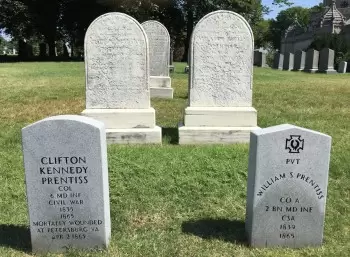

PRESCOTT, JOHN (1818-1904). Private, 36th New York Infantry, Company I. Born in England, Prescott enlisted as a private at New York City on May 9, 1861, and mustered into the 36th New York on July 7. He served until his company mustered out on July 15, 1863, at New York City. At the time of his death, caused by nephritis, he was residing at 45 Cedar Street, Brooklyn. Section 47, lot 6474, grave 2.

PRESTON, WILLIAM E. (1842-1892). Principal musician, 33rd New Jersey Infantry, Company D; private, 25th New Jersey Infantry, Company C. Originally from England, Preston enlisted on September 2, 1862, and mustered in on September 18. He mustered out of the 25th at Beverly, New Jersey, on June 20, 1863. He re-enlisted on August 20, 1863, as a musician, and mustered into the 33rd New Jersey on September 4. On May 5, 1864, he was promoted to principal musician of his regiment and transferred to the Field and Staff. He mustered out of service on July 17, 1865, at Washington D.C. His last residence was 200 Second Avenue, New York City. Section 165, lot 28237, grave 2.